The 2012 category-group contains the floowing categories:
Christmas-12
le Marche-12
Harrow-12
Kaua’i-12
The 2012 category-group contains the floowing categories:
Christmas-12
le Marche-12
Harrow-12
Kaua’i-12
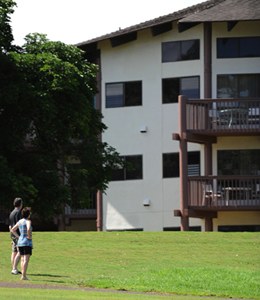
1st entry – kaua’i 2012
This is my second visit to Kaua’i.

The image on the right is of Rose and Derrick looking up at the time-share. The complex is in Princeville, and is situated on a golf-course. (Rose and Derrick are on the cart-path looking up at the apartment we are staying in. The lanai overlooks the 12th tee.)
Once we landed, we headed to Costco to shop for the week. Tomorrow we will go to the farmers’ market in the south and stock up on fresh fruit and vegetables. We will eat breakfast and dinner on the lanai. It’s two of my favorite times. The morning sky is a soft-blue raceway that clouds speed from the ocean to the mountains. In the evening, the sky is star studded.
We are sitting drinking a wine from Puglia and Orion looms above us. To his left is the brightest star in this Tropic-of-Cancer sky. I think it’s Aldebaran, part of the Taurus constellation. Its name – Follower – comes from its position below the Pleiades. (Probably my favorite word in the English language.) Who wouldn’t want to follow the seven sisters? One of them has to be beautiful.


This year we decided to do more walking. And this morning we hiked through the golf-course and down the path beside the fancy Westin Resort to Anini Beach. (As a non-sun, non-sand, non-snorkeling person this is my favorite beach. Yes, I can just hear the reader say, then what the hell are you doing going to Kaua’i?) The waters of Anini Beach sit between the coral reef that surrounds Kaua’i and the white sands of this northern cove. Absent is the under-tow, absent are the mighty waves. Its languid surface is a respite. Its flat waters make it a favorite for first-time triers of parachute surfing.
On our way back, we decided to circumvent the golfers and made a wide arc to the next hole. And there sitting beside the cart-path was an albatross chick. It was bigger than a Thanksgiving turkey. The sign labeled it a Laysan Albatross. There was no evidence of its parents. They must be out with the parachute surfers riding the thermals.
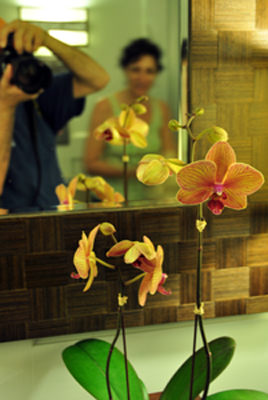

The St. Regis is the fanciest resort on the island and it’s a short walk from the time-share. Last year we went there for mimosas and a glimpse of Puff frolicking in the mists. (The price to see the dragon was exorbitant for a hide-bound budget.) This time we took the steps, along the side of the resort, for our trek down to Hanalei Beach. The resort is built on the cliffs that overlook the bay.
On our way up, we went through the hotel. (It amazes me that you can walk into this super fancy resort and no one asks if you belong. There we were interlopers mingling with the rich-and-famous.) BTW, going back up the cliff through the resort was much like the experience in San Marino where elevators are carved into the mountain and you can ascend to the top in Disneyland comfort.
The elevators ascend through a series of levels, and because you are on the cliff slope, you periodically get off one set of elevators, walk through a fancy lobby to the next set of elevator banks. And even these secondary lobbies are decorated with the best of stuff. I loved finding the orchid in front of the mirror.
(I suspect one of the reasons no one asks if we are staying at the resort, is because I’m walking around with two expensive cameras on my shoulders. I guess looks can fool most of the time. It’s Rose and I in the mirror.)
..
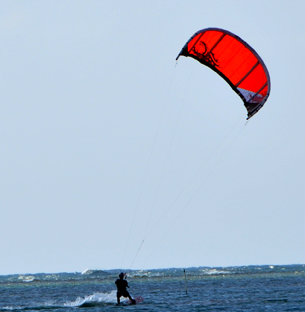

In the morning, we crashed the posh, frou-frou St. Regis, in the afternoon we headed south – the Maha’ulepu area – and drove a dirt road paved with ruts in search of secret beach. (Whenever we go on one of our off-road adventures, Rose is anxious and back-seat drives; I am in the back seat and remind myself that Derrick is a really good driver.)
Secret beach wasn’t as secluded as I had thought. (There are three beaches in the area and we lighted on Gillin’s Beach.) It was full of kitesurfers skating the waves. (Yes, I know the thrill of skating an ice-rink alone in the early dawn – gliding the corners, flying the straight-ways, spinning and pushing backwards. And I love speeding hills on long, waxed skis. But, I’ve never had any desire to surf until I saw the kiteboarders.) The surfer is on a board and attached to a parachute/kite he maneuvers to ride the waves. There were easily a dozen kites harnessing the wind. Their red, green and yellow sails streaked the blue sky.
My favorite part of the show was when the wind would lift the surfer and for a brief moment he was airborne and free. I kept thinking of William Woodsworth’s Daffodils –
.
The waves beside them danced;
but they out-did the sparkling waves in glee.
.
I gazed and gazed but little thought
What wealth the show to me had brought: …
For oft, when on my couch I lie
In vacant or in pensive mood,
They flash upon that inward eye
.
And then my heart with pleasure fills,
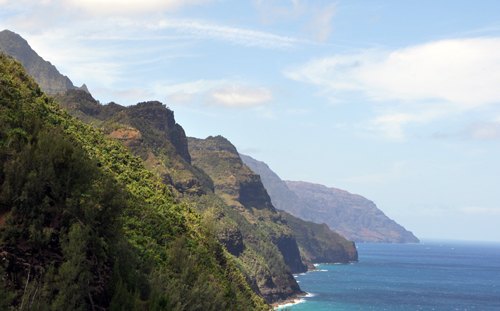

The trail at Ke’e Beach was something that we didn’t get to last April, but I wanted to walk some of it this year. We drove to the end of Route 56, parked and headed up to the trailhead. The park ranger explained the difficulty and the cautioned us against dismissing his comment as over-cautious. (I announced that I was willing to do a mile-and-a-half in. And given that I had a pedometer, I got to monitor the trek. I’m always over-cautious so the ranger’s warning was just a second super-ego affirming my plan.)
To my surprise the trail is well maintained, well marked, well planned and accessible to hiking novices like us. We climbed over rocks, we walked on packed red earth we walked through streams down into the valleys and back up the mountain side. The amazement were the vistas down to Ke’e Beach, the vistas of the Na Pali coast.
Last year I saw these coastal mountains from a catamaran, this year they stretched in front of me. Each bend framing these green giants with their fingers reaching into blue waters.
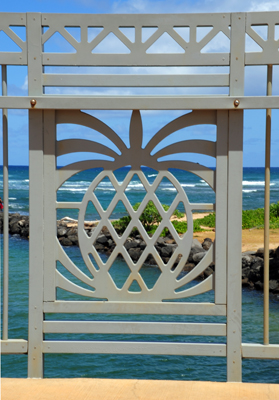
Kapa’a is the everyman town in the north-east sector. (Hanalei is for left-over hippies. Where else would old, bald counter-cultures land, than where the dragon frolics in the autumn mists?) The image is of the railing on the walking-bridge over the Wailua River. The pineapple filigree – a memory of long ago plantation indenture – borders the bridge-deck.

The locals fish from the deck, from the river’s shore, oblivious of the tourists in their Crocs and Keens. In Kapa’a the locals dress down. Here the locals go to bingo-night in cinder-block community centers. Here people have heft; their bodies have curves; their skin is brown; their eyes are coral-black; their hair is straight. (Here the resorts have security patrolling the disneyland grounds, keeping out them locals and making the gate-community native-free.)
The long beach that lines Kapa’a is populated by these locals, these real people who work 8-hour days and can’t sit by the pool basted in SPF 100+ sunscreen. They are the store-clerks, the construction workers, the park-rangers, the teachers. At one end, families fill the pools created by a barrier reef that is 20 meters from shore. At the other end, the reef is broken and surfers ride the waves that sneak through and run to the shore. In between, tourists monopolize the sands, but share the sun.
Along the beach, the town has built a trail that tourists walk. (There’s a voyeuristic element in walking the flat, concrete trail. It’s like come on down and see the real Kaua’i – the old men, their faces cracked like the glaze of ancient pottery, the skinny surfers riding cheap boards, the multi-generational families with no blond children.)
All this sounds rather duplicitous coming from someone who walked the trail, photographed the locals, wears croc slip-ons and keen sandals. Too bad, it’s my journal/blog; I’m the author; I determine content; and I don’t allow comments.
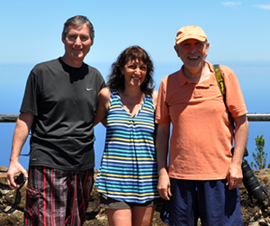
The read this series in chronological order,
click on the category title – Kaua’i-12.

Waimea Canyon, last year shrouded in mist and rain I saw nothing of the gorge. This year, the weather held and there were the green depths, the vermilion sands, the blue skies, and purple waters.
(I rarely post pictures of people, let alone a pic that I’m in, but I thought I’d try it. Some nice tourist took the pic. I set up the shot and told her to keep snapping. She was surprised that I was willing to let her take multiple shots, and once over the surprise, she began to compose shots, change angels, even come in closer. This is the one I like best. I cropped the bottom portion, because I was wearing my bloomer swimming trunks and my legs look like match sticks when I have them on.)
The canyon, on the south-western side, was created by the collapse of the volcano that created Kauaʻi – the oldest island in the archipelago. This canyon, painted in Crayola colors, is part of the Waimea Canyon State Park, one of those government creations that we now seem to dismiss as we wallow in anger and hate in our political discourse.
There are several vantage points, the first is where all the tour buses stop, but we headed for the highest outlook. And there below us in verdant depths, its sides streaked with ochre fingerprints, lay the grand canyon.

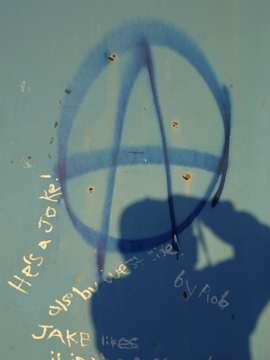
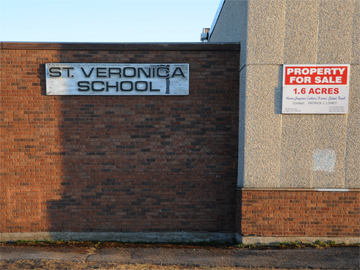 The present building has no windows, no classroom doors to the outside, no immigrant children making new friends.
The present building has no windows, no classroom doors to the outside, no immigrant children making new friends.
In June ’63, my family moved to the West End and for 8th grade I had to go to St. Veronica’s. It was an old school building. Each classroom had its own door to the outside; the exterior wall was mullion windows; and for the first time ever, I had a nun teacher – Sister Drusilla. It’s also the school and the part of town where I met – Frank, Ron and Rainer – three of my lifelong friends.
 A memory is of the four of us playing basketball on the outside court on a Saturday morning and my looking up and seeing the hills golden and crisp with fall. It’s an image still running through my synapses.
A memory is of the four of us playing basketball on the outside court on a Saturday morning and my looking up and seeing the hills golden and crisp with fall. It’s an image still running through my synapses.
It was here we played football and baseball, watered the ice rink for hockey and waited with baited breath while they build a small gym on the creek side. (We got to use it once or twice before we graduated and left for St. Mary’s College, never to use it or visit again.) And it was in our eighth grade classroom that on November 22, a Friday afternoon, Sister Drusilla announced that President Kennedy had been shot.
Fifty years later, the walls are streaked with graffiti, home-plate is littered with broken glass, and chain-link perimeters the creek. The fields and the old-school are waiting for the bulldozer, for the children now grown to visit one last time.
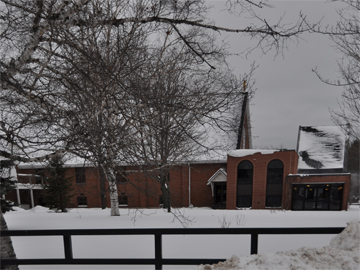
St. Veronica’s is the church where I served as an altar-boy, it’s also the church where Dave and Jo’ got married. It was a simpler building back then without the elaborate, two-part entrance.

I purposely left all the grey in the pic, to remind me of the gloom that was winter in Sault Ste Marie. I remember painting this metal fence the summer between 8th and 9th grade. Back then the parish supported the Catholic Boys High School that I went to and it wasn’t unusual for the parish priest to get work out of the boys that attended St. Mary’s High School on tuition-support. I was in the renovated church four/five years ago when Mimi and I went walking and found it open. The parish priest allowed us to shoot in the sanctuary. It looks nothing like it did 40 years ago.
The parish still has a good size population and I’m glad to know that the area hasn’t been abandoned for the new subdivision plans.

Time period: June 1963 to August 1964
Location: Sault Ste Marie, Northern Ontario
Sentiment: Quiet longing
My family bought a house in Korah – the north-west end of town. I remember going with my dad to look at houses. The realty agent showed us two houses on Turner Avenue, a large older house, which I liked and the smaller house next door which my dad liked. The small house had a truncated roof-peak.
Korah was a neighborhood of older homes and my dad bought the small house on Turner, because it had a double lot and he could expand or even rebuild. (I was more concerned that it was up-the-street from the Tube Mill.) In early July, we moved out of my grandparents’ to our new house. My new school would be St. Veronica’s Elementary.
The journey begins the summer of ’63, when I met the guys that would become my best friends. These were the kids that I played softball with; the kids that I went fishing with. We were the four teenagers that rode double on our bicycles in order to go swimming at Leigh’s Bay. The four friends – Rainer, Ron, Frank and Mario – that played Canasta at Ron’s; that snuck into the Boat Club and played tennis on the fancy courts; that piled into Ron’s car and headed into the back-country.
now I’m going back to Canada, on a journey through the past
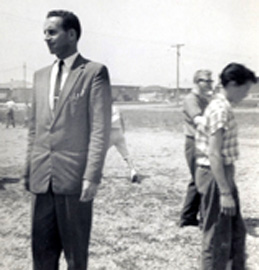
My thinking is that I will use this second entry to situate the time and context for this series.
 The image on the left is of Mr. Murphy my principal at St. Theresa’s. He was my first principal in Canada. When we came in 1957, we lived with grandparents and the school I was enrolled in was St. Theresa’s. (Even though I was 8 years old, Mr. Murphy put me in second grade.)
The image on the left is of Mr. Murphy my principal at St. Theresa’s. He was my first principal in Canada. When we came in 1957, we lived with grandparents and the school I was enrolled in was St. Theresa’s. (Even though I was 8 years old, Mr. Murphy put me in second grade.)
And a memory that is forever burned in my brain is of him giving me the strap, because I was loud and playing on a slide-mound during recess. (He was both handsome and scary.) I never quite figured him out and was glad when my parents bought a house on Turner Avenue and we got to leave St. Theresa’s.
The image of Mr. Murphy reminds me of how empty the area was: there are some bungalows in the background. In the late fifties this was a new subdivision. St. Theresa’s was a newly built school. Most of the families who moved here had left old James Street – the Italian ghetto – for the greener fields of the northern section of the west-end. There was still enough undeveloped land, around the school, for my friends and I to play hide-and-seek in the surrounding fields. And the parish church for the area was St. Gregory established in 1954, three years before we came to live the Soo. The original church was a long rectangular box with a flat tar roof. The idea was that the super-structure would be built once the area filled up with families. (When they finally built the new church in the early 70’s, the basement was demolished and a very different footprint was used.)
I’m heading back up to Sault Ste Marie for the Christmas holidays and am hoping to find some old pictures of old St. Veronica’s Elementary School. BTW, the date on this entry is really December 5, 2012, but I’ve changed it to fit in with the other 8th Grade post.
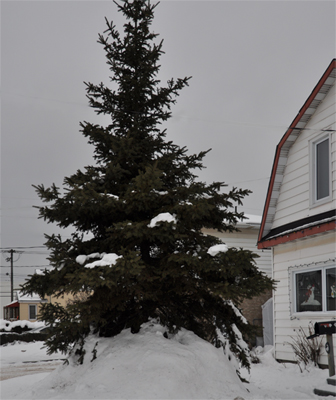
We had moved from my grandparents’ to our new home on Turner Avenue. (I remember going to look at houses with my dad and liking the big old house next door. It’s the house in the pic. The big old house offered 2 floors and lots of options for my own space.) The house they bought was small, but it sat on a lot-and-a-half of land and my dad wanted the added space for a garden. He also believed that the smaller house would be easier to remodel and enlarge. The big old house would be harder to renovate. (My dad has always needed something to renovate or remodel. The little house with the truncated roof-peak was a fixer-upper, right up his alley.)
The house they bought was small, but it sat on a lot-and-a-half of land and my dad wanted the added space for a garden. He also believed that the smaller house would be easier to remodel and enlarge. The big old house would be harder to renovate. (My dad has always needed something to renovate or remodel. The little house with the truncated roof-peak was a fixer-upper, right up his alley.)
Shortly after moving in, my dad began to dig out a basement and it was my job to carry the cinder-blocks from the pallet to the mounds of earth that lined the perimeter of the dig. (I hated the job, because it meant chores rather than going out to play with the new friends I was making.) And yet watching my dad, his friends and relatives dig the earth from under the house was an adventure. I could jump down and walk the footer, inspecting the cribbing columns and hydraulic jacks that now held our house. (But never far from my mind, in that summer of 1963, was the fact that in a couple of months I would be going to a new school – St. Veronica’s.)
The actual date of this entry is Sunday, February 17, 2013.
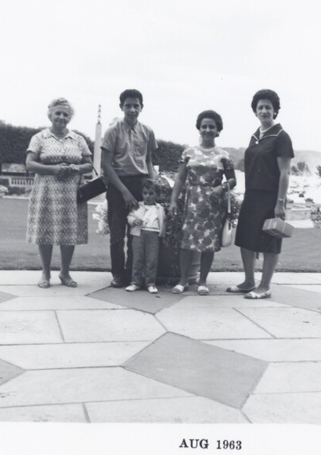
The summer before 8th grade, I went to Toronto with my uncle, aunt, Rose and my grandmother. On the ride down, I remember going in and out of rain-showers. We were driving Highway 17 and we’d go through sheets of rain and then come out onto dry weather only to go through the next sheet. It’s an experience you can have only traveling in a car.
 The image on the left is us in Niagara Falls. (Left-to-right: Maria, Mario, Rose, Egilia, Nunziata) It must have been a side-trip. I bought Mafalda these Niagara Falls decorated shot-glasses that she still has 50 years later. The other memory I have of that trip was my staying at my grandparents’ rather than with everyone else at Nunziata’s. (That too felt grown-up – being allowed to go on the trip and then being allowed to stay somewhere on my own.) The trip was also the end of a period in my life, a time I associated more with the Perri side of the family than the Zingas. It was the bookend to our trip from Calabria, because the next phase was really about being Canadian. Living and being with the Perris was the first experience after immigrating. Now, on Turner Avenue, I would be able to write my own story.
The image on the left is us in Niagara Falls. (Left-to-right: Maria, Mario, Rose, Egilia, Nunziata) It must have been a side-trip. I bought Mafalda these Niagara Falls decorated shot-glasses that she still has 50 years later. The other memory I have of that trip was my staying at my grandparents’ rather than with everyone else at Nunziata’s. (That too felt grown-up – being allowed to go on the trip and then being allowed to stay somewhere on my own.) The trip was also the end of a period in my life, a time I associated more with the Perri side of the family than the Zingas. It was the bookend to our trip from Calabria, because the next phase was really about being Canadian. Living and being with the Perris was the first experience after immigrating. Now, on Turner Avenue, I would be able to write my own story.
This is the first time I’ve connected the trip to Toronto and Niagara Falls to the summer of 1963. (It was an amazing year for change – moved to Turner Avenue and away from the connection to Calabria, went the Toronto and Niagara Falls without my parents, went to a new school and met the crew that would become my best-friends.) Had no idea these events all occurred that year.
The actual date of this entry is Sunday, February 17, 2013.
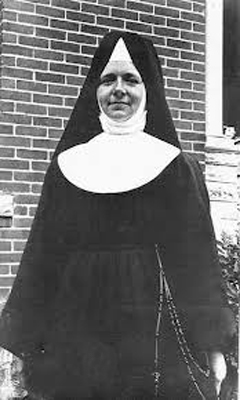
Sister Drusilla was the principal of St. Veronica’s School. She was also the 8th grade teacher. And she was a Sister of St. Joseph. It was the first time I had had a nun as a teacher. Back at St. Theresa’s there were no religious teachers, all were lay-people. Only the older elementary schools in the older neighborhoods had nuns and St. Theresa’s was one of the new schools in a newly-built, Henrietta Street community. 
Having a nun as a teacher was strange for me. My memory of nuns was from when we were living in Aprigliano and Mafalda took me to Pietrafitta – the next hill-town over – to visit a preschool. The experience was horrendous. I hated the nun who walked us around; i hated the jail-like building; and I hated my mother for taking me there. I still have pictures in my head of massive, wrought-iron gates blocking cells and rooms and of a big, fat nun with a huge smile who I was sure was going to lock me up and beat me if my mother left. Mafalda tells the story of an out-of-control child who embarrassed her – screaming, carrying on and holding on for dear life; a child who had to be taken home and promised never to be sent back to that place. (My dad, being a man who didn’t trust nuns, was an ally.) And for the next 10 years, I was nun free.
There were two Sisters of St. Joseph at St. Veronica’s; the second one taught in the lower grades; and she was younger than Sister Drusilla.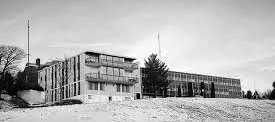 They were driven to school every morning and picked up every evening and taken back to their convent at Mount St. Joseph College. The image on the right is Mount St. Joseph College as I remember it. The right hand side was the girl’s high school; the left hand side was the convent.
They were driven to school every morning and picked up every evening and taken back to their convent at Mount St. Joseph College. The image on the right is Mount St. Joseph College as I remember it. The right hand side was the girl’s high school; the left hand side was the convent.
I have to say that I got along with Sister Drusilla. Not that she was warm-and-fuzzy, there was nothing nurturing about this Irish-Canadian, but I could appreciate her sarcasm and mean sense of humor especially if it wasn’t directed me.
The actual date of this entry is Tuesday, February 19, 2013.
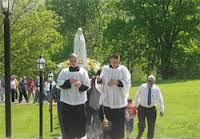
Francesco Bitonti and I have been talking a lot about our experiences in 8th grade and I keep being surprised by how different the two sets of memories are. He had lived in the West End and done most of his elementary schooling at St. Veronica’s. I came in 8th grade and did one year. He knew everyone in the class; they had been together the last six years. I knew no one and I don’t even remember how Frank and I met.
So, I asked Francesco if he was interested in conducting a dialogue. He’d write about topics and memories as I would, and we would comment on each other’s remembrances. Here is one of his first entries. The rally was in May of 1964.
Marian Day Rally and My Second Strap at St. Veronica’s
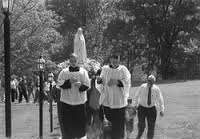 I don’t know if you recall this, but the Marian Day Rally was a Catholic procession in praise of the Virgin Mary held on the first or second Sunday in May. We had promised Sister Drusilla to be part of the rally with other students. However, on that Sunday, my dad needed our help, Joe and myself and even Nicky Porco, to nail down some roofing shingles on the garage. I don’t recall how Mike Rossi got into the picture. He was probably just watching us doing the shingling. Not one of us – Joe, myself, Mike Rossi or Nicky Porco – attended the Marian Day Rally that day. We had all committed to being there. On Monday, we were grilled by Sister Drusilla, who then proceeded to call in Mr. Tokar to strap the four of us because of our spiritual indiscretions. When my dad got wind of this, he was livid and was going to go down to the school. We begged him not to go. He took our advice. The scars healed easily.
I don’t know if you recall this, but the Marian Day Rally was a Catholic procession in praise of the Virgin Mary held on the first or second Sunday in May. We had promised Sister Drusilla to be part of the rally with other students. However, on that Sunday, my dad needed our help, Joe and myself and even Nicky Porco, to nail down some roofing shingles on the garage. I don’t recall how Mike Rossi got into the picture. He was probably just watching us doing the shingling. Not one of us – Joe, myself, Mike Rossi or Nicky Porco – attended the Marian Day Rally that day. We had all committed to being there. On Monday, we were grilled by Sister Drusilla, who then proceeded to call in Mr. Tokar to strap the four of us because of our spiritual indiscretions. When my dad got wind of this, he was livid and was going to go down to the school. We begged him not to go. He took our advice. The scars healed easily.
I have no memory of a rally or of being invited to participate. Joe is Frank’s older brother, Nicky Porco lived across the street from Frank and Mike Rossi lived down on Douglas. The three of them were a year older than Frank and I. Also, I vaguely remember a Mr. Tokar. Frank says he was the 7th grade teacher.
The actual date of this entry is Thursday, March 7, 2013.
This next memory from Francesco had me laughing out loud. (I read the email, while at my desk at work, and I began laughing. The other three admins in the office all wanted to know what was going on. I told them that once I had incorporated the info into the journal, I would send them the link to the hot Italians.)
End of the Year Party – Hot Italians
I don’t know if you remember Kenny Gibbs. He was this preppy, blond kid in our class. He got a lot of attention from the girls. It was June of 1964. Joe and Mike Rossi were planning this grade 8 end-of-year party at someone’s place. I remember that it eventually was held at Tony Guzzo’s house. His father was quite liberal and saw Tony as the next Ringo Starr.
At any rate, sister Drusilla somehow found out about this private party and she apparently told Kenny Gibbs to tell the girls to be very careful because Italians can get very hot. Even at early stages of puberty, I understood the implication. Nature had damned Italians to an uncontrollable sexuality. I don’t know if you were at the party or not. But there was some spin-the-bottle and a few innocent kisses but not much more. The Drusilla curse had struck!
I don’t remember a Sister Drusilla that was that connected to what we as kids were doing. In my memory she was this distant, tiny woman with a wicked sense of humor. And no, I wasn’t invited to the end-of-year party.
The last time I saw Frank in late February, he talked about the various sports and teams that were organized all through the West End. He talked about having played ball and hockey on neighborhood teams while growing up. And that these peewee teams were a strong tradition in the area. I knew nothing about the teams or their organization. Moving into the neighborhood at 8th grade and then going off to a high school at the other end of town kept me out of the network. And as the new kid, it also kept me from getting invited to parties.


The sentinels line the drive; stand guard against the invading maize. In Tuscany they would claim cypress heritage, but here in Harrow they pledge allegiance to the arborvitae. The setting sun exaggerates their height. And these giants bar the stalks that march in goose-step through the land-grant fields, from reaching the driveway, from reaching the house.
They’re the markers I look for when I scan the horizon while driving north on Erie Road. They’re the beacons in a sea of corn. They tell me I’ve reached land – Lynn-and-Rainer’s farm.
It’s odd to write about Harrow, Ontario and reference Tuscany. But the beauty I associate with that Renaissance state is mirrored in this languid landscape, in this new world of Upper Canada, in these tall sentinels that border Lynn-and-Rainer’s farm. In Tuscany the rolling hills provide the privacy and the cypress the boundaries, in Harrow the genetically modified corn wraps the property in its green arms keeping out the rest.
Bet the British never thought that some old Italian immigrant would compare the land-grant fields they doled out to the land of Botticelli. Bet those early settlers never thought that the daughter of Portuguese itinerants would own their manor homestead. Bet those early Canadians never pictured a bunch of immigrants – German, Portuguese and Italian – sitting on the porch talking and talking into the night and never thinking about working the fields.
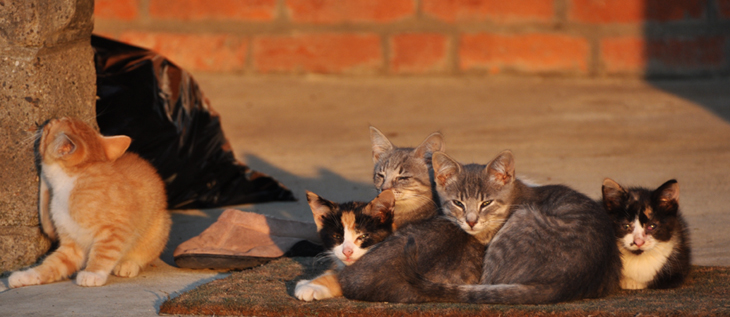

I woke up Saturday morning to this scene. Actually, after they realized I had no food and meowing didn’t change the fact, they abandoned their whining and went to sit in the morning sun. Immediately their cat-eyes were at half-mast. (The orange tabby was too rambunctious to sleep and she had an itch to scratch.)
Rainer told a gruesome story – a couple days earlier he was woken up in the middle of the night by loud screeches. He went downstairs, opened the door to see a coyote on the porch, one of the mother-cats in its mouth and blood all over the cement flooring. Startled, the coyote ran back into the corn, but not before leaving behind two dead kittens and the recently mothered cat half dead. Lynn helped the dying cat out of her misery. But the two remaining kittens, from that litter, are now orphaned. (The greys are from the litter whose mother was killed by the coyote.)
Lynn and Rainer feed and interact with the feral cats on the property. This pride is healthy, free of fleas and almost not-feral. They are great fun to watch. The kittens do all the silly things you expect, but their behavior is exaggerated given that there are over ten of them. (The kittens are from three mothers.)


Left home yesterday to make a 5:40 flight to Philadelphia. Between engine trouble and delays, didn’t leave until 7:00. My flight from Philly to Frankfurt also got delayed. Supposed to leave at 8:30, but didn’t leave until 10:00. (BTW, the Philly airport is new, and very nice. Even had charging stations, so my kindle and iPhone were fully charged.)
Made it to Frankfurt with an hour to go. (They had already booked me on the 6:00 pm flight assuming I would not make my 12:40 connection.) From the air Germany looks a lot like Pennsylvania in that it’s very green. The difference is in the clustering of the towns. For us, rural Pennsylvania is spread out. Rural Germany is clustered very close together and the surrounding area is all woods or small farms.
I made sure to deplane as quickly as possible, then at Passport Control I asked if I could go first and the efficient Germans let me. Next, I ran to the gate and made it with 20 minutes to spare. Rose and Derrick were happy to see me, otherwise they would have had to wait in Bologna until the later flight got in.
With all that hassle out of the way, the next worry was luggage – would my bag make it onto the Bologna flight? It did, we landed at 2:00. But the line from hell was waiting for us.
The next step was to pick up the rent-a-car. By 2:15 we were in line at Budget. We didn’t get up to the counter until 4:00. The drive to Earle-and-Suzanne’s (Isola di Fano) was supposed to be an hour-and-a-half. It took us three hours. On the Autostrada, we met up with all the Italians who were heading to the beach for the weekend.
We got in at 7:00. Ran down to Fossombrone to the grocery store, came back showered and had our first dinner in Italy. We polished off two bottles of wine between the three of us.
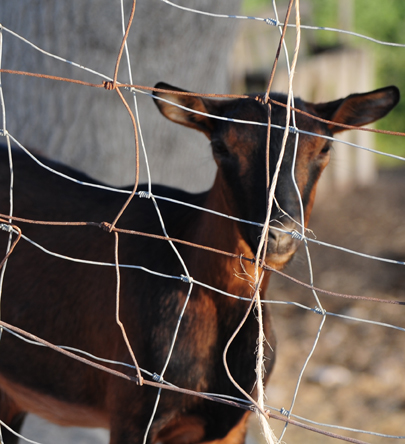
The farm up the road from us, has turkeys and goats. I love the billy-goats. And like Rainer’s cats, when I walked by they expected food – sorry guys!!

(It’s time to cook and eat. I’ll come back after supper.)
Today was a get-adjusted-to-the-local-time day, so we decided to explore the surrounding area. We went to the Gola del Furlo. It’s the valley and gorge of the River Metauro. It’s also the old Via Flaminia, the ancient road from Rimini to Rome.
So first about the house and my morning trek – the fields are different than last summer. Cut wheat-stalks cover the fields that last summer were plowed. There are no farmers plowing into the night, instead the fields are yellow with mowed wheat and bales of new-tied hay. At the farm next to us, the turkeys are still there and so are my favorite billy-goats. (This morning there was a breeze from the north; could it be the tramonto? And it perfumed the air with cow manure.) The waking sun crested the hilltop. I wanted to walk the field the sun lifted from, but it was too far away; maybe tomorrow morning.
At 8:30 the valley was alive with church bells. Yes, it’s Sunday and the bells called all to Mass. For me, the bells pulled memories of long ago. They are the Pavlovian bait that grabs me and throws me back to Calabria, to the late 1950’s; to a time when the rhythms of my life were governed by the agrarian and Roman Catholic calendar that acculturated me.
It’s midnight. Rose and Derrick have gone off to bed, and I’m blogging. I’ll finish the posting about the Gola del Furlo tomorrow morning.
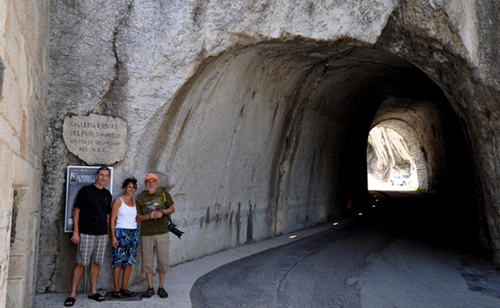
We decided to explore the gorge – Gola del Furlo – not realizing that the tunnels through the gorge were chiseled out by the Romans and their slaves. Who knew that the old Roman road la Via Flaminia was less that 20 kilometers from Isola di Fano. (Vetruvius was supposedly the architect for the tunnels through the gorge of the Metauro.) It’s amazing to realize that the two tunnels were hollowed out by hand. The pick marks are still there.

The structure on the left of us is a small un-consecrated church. (Also, between the two tunnels, was a grotto and some Italian put a statue in it. Whoever said stereotypes are not valid just has to look at the grotto with its madonna, votives and plastic flowers.) There was a young man, a volunteer, who told us all about the Via Flaminia. (In Italy, it’s young men who volunteer at churches and local museums. No sign of the old, retired ladies that volunteer at similar places in the U.S.)
The Italian word for tunnel is galleria. Rose keeps saying that the words sound so much prettier in Italian. The German overtones that permeate English are not there in la bella lingua.
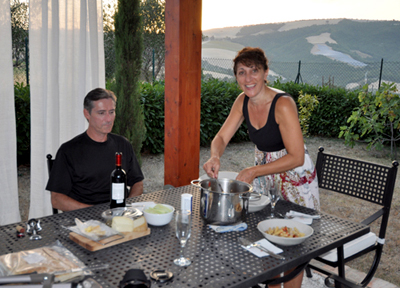
It’s Sunday, it’s August, the natives are no where to be found and nothing is open. (We knew that, hence the mad rush to the grocery store last night.) So we had to figure out supper. We settled on pasta with a sauce of fresh, sauteed tomatoes, chopped artichokes in oil, sauteed red pepper, and porchetta – a pork roll stuffed with wild fennel and garlic.

The pergola is an al fresco dining area on the property. We waited until the sun went down and then brought our food to the wrought iron table under the canvas awning.
The image is a repeat from last summer, when we sat down for my first meal in Le Marche. Then too Rose had made pasta with a fresh tomato sauce, and like last summer we ate under Earle-and-Suzanne’s pergola. It’s actually a stretch of the word, but it’s a wonderful structure, so un-Italian.
The property looks different than last year. Earle-and-Suzanne have tackled the garden area and are beginning to make some real changes to the ivy covered bank that is the base for the top-half of the property. (I love it when a property has different elevations, even if only a difference of two or three meters. My dad’s vineyard in Calabria was on three different elevations, and I remember how fun it was climbing the into-the-hillside steps between the three fields.)
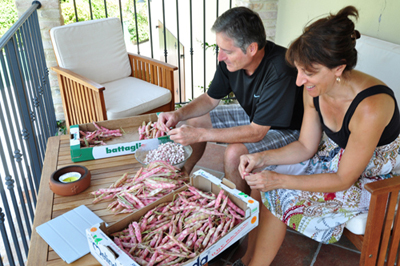
For Welch …
We got up early and headed down to Fossombrone for the weekly farmers’ market. (Fossombrone is the municipality that the house we are in, is part of. Isola di Fano is the village that the house is in.) The markets are a mishmash between fresh fruits-and-vegetables, household items and clothing. In my mind, it’s the mall coming to the consumer and therefore my kind of thing. Young Italians are more willing to go to the indoor box-store malls with parking and chain stores. However, so far there is not a critical mass heading to the box-store malls and the outdoor markets are still busy and vibrant.
I love all the fresh fruits and vegetables, my kind of thing, and not having to go to a mall or a Giant Eagle kind of store is an added perk. We walked around looking at all the products and then we settled on the one or two vendors we liked. This ‘liking’ is a gut feeling consisting of answers to questions such as – do they have nice looking sales clerks? are they pushy in their sales pitch? are they helpful and tell me things I don’t know? are they willing to let me pick out my own tomatoes? are they snobs with airs? (You have to ask this of Italian vendors. Snobby usually means a 10% increase on the sales price. And given that I can be snobby with the best of them, I can pick them out immediately and I’m not giving my money to snots. I may be one, but I’m not paying extra for the priveldge of being with my kind of people.)
When I go with Rose and Derrick to these things, I’m the voice of reason. Left to their own devices, they would buy everything in sight. When it comes to food buying their frugal approach to life goes out the window. Derrick saw the cranberry colored beans – faggiole Borlotti – and then decided to buy three kilos. Now the debate is – “Do we take them home to Michigan or eat them here?” Even my mother urged them to eat them fresh and cook them immediately. (They decided to take them home to Michigan.) Once we got back fromt the market, they sat on the porch and husked them into a bowl. (I love the fact that an iPad is on the table as they surciano le surache an old Calabrese expression for shelling beans.
Once we got back fromt the market, they sat on the porch and husked them into a bowl. (I love the fact that an iPad is on the table as they surciano le surache an old Calabrese expression for shelling beans.
Lunch was fresh tomato salad with green onions and basil, a picante local cheese and these wonderful cucumbers. Rose and I put as much bread into the salad oil as we could jam. There is nothing as wonderful as Italian bread soaked in tomato salad juices.
The afternoon adventure was a trip to Fano to the TIM’s store to put in a new sim card into Derrick’s phone so that next week we could use it as a hot-spot. (Earle-and-Suzanne’s was not available for our second week, so we booked at an agriturismo – La Tavola Marche – and they do not have Internet.)
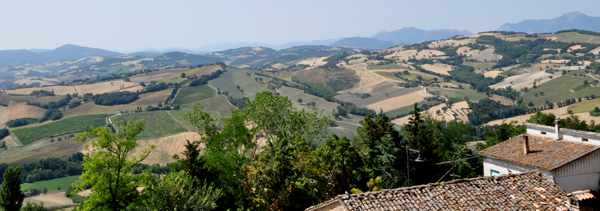
Earle-and-Suzanne’s house is in the Metauro River valley; it’s on the northern slope of the rounded hills that form the valley below us. Each morning I look out and see the hilltop towns of the next valley, and I’ve wanted to go exploring these structures that shape the horizon. Today was the day to explore the next valley to the south of us. We drove down to Isola di Fano and then up the mountain and into the next valley. (Derrick had put in ‘off-road’ when he was setting up the GPS, and Rose yelled and yelled. The off-road trip would have taken us 3 hours, the fastest-time trip had us at Fratte Rosa the hilltown we see from the kitchen window in 30 minutes.) The interior of Le Marche is these cultivated, rolling hills. And this patchwork is one of my favorite landscapes.
The interior of Le Marche is these cultivated, rolling hills. And this patchwork is one of my favorite landscapes.
Our first stop was to Fratte Rosa and immediately there were signs of foreigners. The entire town has been beautifully refurbished; all the houses have been cleaned and pointed. (It reminded me of Assisi. Modern day Assisi is the disneyland of Catholicism. The entire town has been refurbished to keep the tourists with loaded pockets coming. Forget the fact that Francis made poverty a virtue, modern day Assisi is anything but poor.)
The next evidence of foreigners was in San Lorenzo in Campo. (It was full of tall, blond Germans.) I did forgive them their invasion, because we found a Frutta e Verdura shop where the owner sold us the best Visciolata wine ever. This is a dessert wine made in Le Marche. It’s made from wild cherries mixed with wine. I walked in and asked if he would sell us a bottle of wine and then open it so we could have it for lunch. Of course he would. Well, he ended up having to uncork two bottles before he was successful at getting the plastic cork out. He put those two bottles aside and he picked out a third with a real cork that he was able to remove. We now had our wine. Earlier I had bought two slices of pizza with bacon and eggplant, Rose and Derrick had paninis stuffed with porchetta. (I told the owner of the Frutta e Verdura that in America it would be illegal for him to open the wine and then sell it to us. He said American is very open, but very contrary.)
We drove to the next small town and sat in the piazza in the shade and had our picnic lunch. Oh yes, the man from the Frutta e Verdura packed us three plastic cups. After our piazza lunch I went over to the local real estate office. (It was the only business still open.) It listed all these farm-houses for sale. Some were completely restored,, others were ruins. The prices were beyond high. They were so over-priced that I couldn’t believe people were paying these prices. I guess the Germans dodn’t see the prices as exorbitant, highway robbery, out-right stealing …
The Viscolata we had after dinner with fresh melon. (Rose is already planning a trip back to San Lorenzo in Campo to buy more Viscolata. She’s planning to take at least one bottle back to Michigan. I’ll think about it throughout the year and it will become another reason to return next summer.
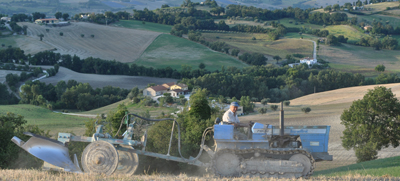
The weather has been miserably hot, but last night it broke. And at 2:00 in the morning the farmer from the next property was still plowing. I understand working in the cool night, but am amazed by the practicality of it all.
 In many ways that’s what keeps surprising me about Italy – how practical everything is organized. The problem is that this orderliness is severely taxed in the summer months when the country is overrun with mobs, and I mean that in a literal sense, of foreigners. And then we all whine about things being inefficient. I wonder if any country can efficiently manage the millions that descend into Italy each summer. Disney can do it at a theme park, could it do if for a whole country? Especially when the locals have to continue their day-to-day routines – go to work, cook, visit, go to doctor’s appointments, go food shopping – all while the tourists, who have left their day-to-days back home, want entertained, want no interruptions, want immediate service, want no traffic jams, want cool days, want people who speak English …
In many ways that’s what keeps surprising me about Italy – how practical everything is organized. The problem is that this orderliness is severely taxed in the summer months when the country is overrun with mobs, and I mean that in a literal sense, of foreigners. And then we all whine about things being inefficient. I wonder if any country can efficiently manage the millions that descend into Italy each summer. Disney can do it at a theme park, could it do if for a whole country? Especially when the locals have to continue their day-to-day routines – go to work, cook, visit, go to doctor’s appointments, go food shopping – all while the tourists, who have left their day-to-days back home, want entertained, want no interruptions, want immediate service, want no traffic jams, want cool days, want people who speak English …
This morning the farmer is back out, I heard the tractor as early as 6:00. He’s spreading manure in the lower field, and because the wind is blowing away from us, there is no perfumed air.
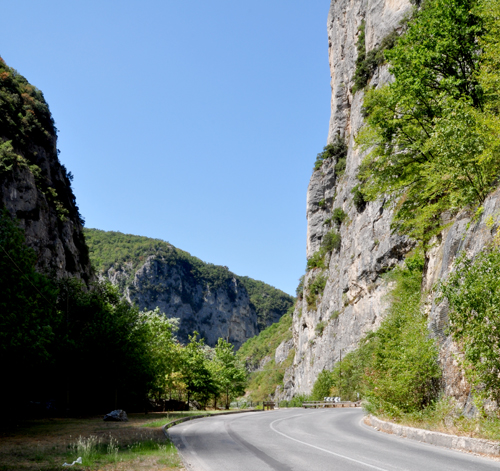
We decided to head south to the caves at San Vittore. This southwestern region is full of caves; the best know are the Grotte di Frasassi. To get there, the GPS took us on the provincial roads that hug the mountains. (In Italian there are different words for mountains depending on their shapes. In Calabria, with its Sila peaks, they’re montagne. Here in north central Le Marche, with its tall rolling hills, they’re colline. I love the ride through the center.
I love the ride through the center.
These are the provincial roads and the only arteries into the country with amazing vistas. (The tolled Autostrada and the non-tolled Supra Strada run in valleys, on flat terrains, along the coast, along the side of mountains, through tunnels in gorges. They are full of traffic – foreigners and locals. For the Italians speed limits and traffic laws are only suggestions. This drives the foreigners crazy. I like the Italian word for foreigner better than the English. In Italian foreigners are stranieri. Our word strange is wrapped up in the Italian comment about people not like them.) The provincial roads are the only access points for people living in the interior. They lead to all the postcard-perfect hill towns we see in travel brochure. But because most stranieri aren’t willing to deal with the roller-coaster ride that the provincial roads offer, they avoid the interior.
The image in this post is the gorge where the Grotte di Frasassi are located. Before we got here, we stopped at a local supermarket and bought lunch. You buy all the ingredients for a panino and the clerks assemble it. We left the store with two panini, two slices of pizza, some olives and both carbonated and non-carbonated water – lunch. There was a picnic table on the right. We sat there and ate out grocery-store lunch. (My pizza was bland, but that’s what I expected when I bought it at the large, chain store.)
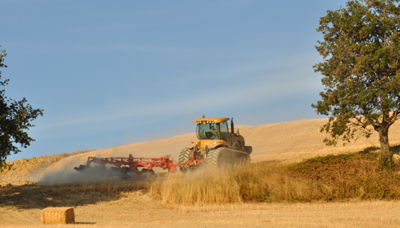
It’s 10:00 pm local time and the farmers of the valley are plowing. The evenings are cool and the night sky is black with stars. The farmer from up the road is driving his blue tractor making patterns in the hillside. If last night is any indication of his work schedule, he will be at it all through the night. The farmer is using a huge tractor to plow. I shot a series of pictures as he came down the hill, the plow into the earth. (The gold haze of the mowed wheat fields is one of my favorite colors.) Coming from a country and city where farm rhythms are things of the past, it’s hard to put my head around the work routines here in rural Le Marche.
Coming from a country and city where farm rhythms are things of the past, it’s hard to put my head around the work routines here in rural Le Marche.
Today we drove through Senigallia, one of the premier beach resorts on the Adriatic. I bet no one there works through the night plowing fields. I bet no one there knows anyone who makes their living plowing fields.
After supper, Derrick and I took a walk up to the old abandoned house I found the other night when I went into the fields to shoot. The field is the highest point on this side of the valley and I wanted to shoot from that vantage point. And there in the trees at the top was an old farmhouse. I figured out where the driveway was and tonight we make the trek back up the house. The view is truly spectacular. From the property you have a 360 degree panorama.
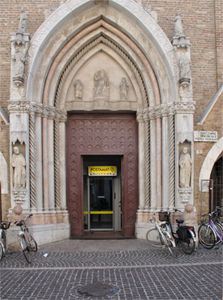
Today we drove to Pesaro and the northern coast. Where Senigallia is overrun with tourists and frantic, Pesaro is full of locals and slow. The streets in the old town are shadowed by trees, and the beaches are orderly if riddled with umbrellas. We got there early enough to walk the streets with the locals. Near the government center, an old church had been retrofitted into a post office, and I decided that would make a great shot, so I walked across the street to shoot the facade with the yellow postal sign inside the main entrance. A young man came up to me and began a harangue about the injustice of having retrofitted a church. He then asked if I was from Pesaro, I went into a full-American pretending I had not understood him and that I was a lowly tourist. He looked disgusted, but left. (So, was the disgust about the injustice of government taking over a church or that I was an American who only spoke one language – American English?)
We got there early enough to walk the streets with the locals. Near the government center, an old church had been retrofitted into a post office, and I decided that would make a great shot, so I walked across the street to shoot the facade with the yellow postal sign inside the main entrance. A young man came up to me and began a harangue about the injustice of having retrofitted a church. He then asked if I was from Pesaro, I went into a full-American pretending I had not understood him and that I was a lowly tourist. He looked disgusted, but left. (So, was the disgust about the injustice of government taking over a church or that I was an American who only spoke one language – American English?)
BTW, most of the English you find here is British English – axioms, spellings, terminology. For example, at lunch the menu had an English translation. I wanted a salad, and I’m looking at the ingredients in English and one of the items was ‘rocket’. What the hell is rocket? There’s no such vegetable with that name. Rose told me that rocket is arugula. And that the British call it rocket. What!! (It may come from the other word for arugula – rucola. But how do you get rocket from rucola? Only a culinary challenged society could call an edible grass a rocket.) Another item for my list of Things-to-Hold-Against-the-British.
I probably need to re-examine my comments. The young man from Pesaro was ranting against the government take-over of church-owned buildings, I’m here ranting about the British. I guess all Italians have something to harangue about, even old ones who now live full-time in America.
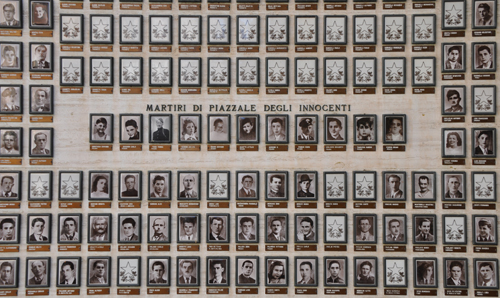
World War II still shapes the Italian character. My family left after the war, and here I am back.
People of my parents’ generation lived through the war years and their children carry that legacy without even knowing it. It took me a while to understand how the war changed my life. Because, my parents were too young to participate, I never thought that their actions and decisions were the result of what the war had done to their homeland. I just assumed we left for Canada, because all the grandparents were there. Certainly never thought about the fact that the economy of post-war Italy was in the toilet and my dad could not make a living.
And growing up in Canada and the US, the war stories were about winning. The books we read in high school were about British men and women who fought valiantly and won. I didn’t hear about the holocaust until I moved to America. And still no one ever talked about Italy in the war except to mention Mussolini. (I came to hate Winston Churchill’s writings. They tell a one sided story. In the writings he has no understanding of what the regular people of Italy and Germany suffered. He has no empathy for the victims of the war. Instead he brags about the resolve of the British people and the low character of the Germans and Italians.) There are World War I memorials in all the piazzas of all the small towns. World War II memorials are rare. The one in Pesaro was disturbing. It’s a wall of funereal pictures of the freedom fighter.
There are World War I memorials in all the piazzas of all the small towns. World War II memorials are rare. The one in Pesaro was disturbing. It’s a wall of funereal pictures of the freedom fighter.
This part of Italy was the Gothic Line – The Gothic Line – Linea Gotica – formed Germany’s last major line of defense in the final stages of World War II along the summits of the Apennines during the fighting retreat of German forces in Italy. The Allies breached the Gothic Line on both the Adriatic and central Apennine fronts during Operation Olive also known as the Battle of Rimini in the autumn of 1944. Over a million men participated in the battle.

How can I pass up a title like that, even if it doesn’t mean anything to people who read this?
After Pesaro we headed north on the winding coastal road that runs along the top of the Apennine ridge; the vistas down to the Adriatic are wonderful.
(Some facts – the road on the ridge is lined with Renaissance mansions. Rich Italians, to escape the blistering summer heat, went to the mountains not the sea. Only poor people, who lived in the mountains throughout the year, would go to the beach for a summer break. The villas of the rich look out onto the Adriatic. The servants would open the house sometime in June and spend the next months cooking the local cuisine. The landowners sat on their verandas and were waited upon.)
The cliff area, outside of the Pesaro, is a national park. And during World War II, this was the Gothic Line that the Germans defended until they lost it in the Battle of Rimini.
At the end of the ridge is the resort town of Gabicce Monte a small quaint mountain-town full of restaurants that cater to the beach crowd. We had lunch at one of these restaurants. I ordered a salad – I can’t do a full lunch and not go back to the house and sleep for the afternoon. (In this way, I’d fit in perfectly with the Italian afternoon routines.) Rose was scandalized that I would order a simple salad when I had a full menu of Italian specialties to pick from. (This was the menu that listed ‘rockets’ as an ingredient in my arugula salad.) Below us, Gabicce Mare is the small coastal town at the north-eastern border of Le Marche and Emilia Romagna. The area is actually two towns, Gabicce Mare on the Le Marche side and Cattolica on the Emilia Romagna side. The pic is shot from our table at the restaurant that served rockets in my salad. The lines in the water are breakers – stone walls to keep the tides away from the sun-bathing public. (I suspect that there are no dermatologists in Italy. No one would pay any attention to their advice about staying out of the sun. Remember, the Italians embrace the sun – O Sole Mio.)
Below us, Gabicce Mare is the small coastal town at the north-eastern border of Le Marche and Emilia Romagna. The area is actually two towns, Gabicce Mare on the Le Marche side and Cattolica on the Emilia Romagna side. The pic is shot from our table at the restaurant that served rockets in my salad. The lines in the water are breakers – stone walls to keep the tides away from the sun-bathing public. (I suspect that there are no dermatologists in Italy. No one would pay any attention to their advice about staying out of the sun. Remember, the Italians embrace the sun – O Sole Mio.)
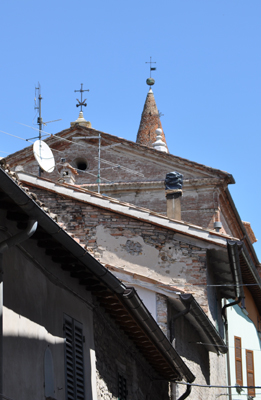
Today is our last full-day at Earle-and-Suzanne’s. (Tomorrow we head over to La Tavola Marche.) We decided to have dinner at a restaurant, in San Lorenzo in Campo, that specializes in farro dishes. San Lorenzo is in the next valley to the south of us and to get there you literally go over the mountain and through the campi.
Because of our dinner reservations, we decided to explore close to the house and Urbania fit the bill. It’s claim to fame is a Befana festival in early January. It’s a small town on the cusp of renewal.
 The town was quite lively and full of Italian tourists and foreign students. (There is an international school here and kids come from all over to the music academy.)
The town was quite lively and full of Italian tourists and foreign students. (There is an international school here and kids come from all over to the music academy.)
After our exploration we stopped at a gelateria and it had a Nutella flavored gelato. I had to have one. It was really not good – too much Nutella and not enough gelato.
The next eating adventure was at the Farroteca in San Lorenzo in Campo. The drive over, as I said, was over the mountain. (We go by one of my favorite hill-towns – Fratte Rosa – and I think I like that valley more than the one we are in.) We parked in the main piazza and walked the short distance to the restaurant.
The place is on a property with three structures – a villa, the itinerant farmers’ residence that is now modernized and the old animal shed that has been renovated into the restaurant. The owner – Lea – is this vivacious older woman who had us laughing throughout the entire meal. (She complained loudly about the Italian version of Socialism and was taken back when I told her that millions of Americans don’t have health care. Her answer was, “Questo non e gusto.” – That is just not fair.
Dinner was great. It was a fixed menu. We began with a farro salad. (The olive oil is from her property across the valley – Monterosso – and tasted amazing.) This was followed by cheese with prosciutto and small farro breads topped with olives and zucchini. The third course was a fresh, soft cheese on farro pita. The primo piatto was ricotta ravioli with porcini mushrooms. This was followed by sweets served with the local dessert wine – Visciolata – and espresso finished the meal. (We had a bottle of red wine from her vineyard and two liters of sparking water with our meal.) The entire dinner cost us 75 euros.
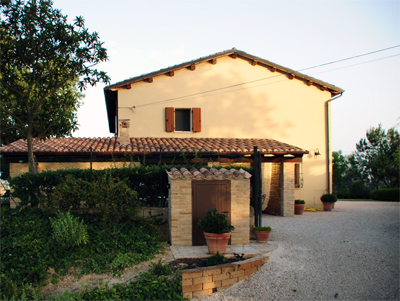
Today is our last day at this great house.
 Last year, Rose found this listing and we decided to take a chance. I believe our expectations were what they had always been – probably looks better online than it really is. We were wonderfully surprised.
Last year, Rose found this listing and we decided to take a chance. I believe our expectations were what they had always been – probably looks better online than it really is. We were wonderfully surprised.
The house is a restored itinerant farmers’ house. (My dad’s family lived in such a house in Calabria. The property owner housed the workers in various such houses on his property.) The ground floor was where the animals were kept and the first floor was where the family lived.
Earle-and-Suzanne have restored the ground floor and they live there. The first floor is the rental. The tall beamed ceilings are all visible, the kitchen is very efficient and comfortable. There are two bathrooms, one en-suite and very large second one. One of my favorite things about the house, and I know there are many, are the views. You get up in the morning to the manicured valley. (The house sits on a hill in the middle of the Metauro Valley.) We sit on the porch and have our morning espresso.
We’ve been going exploring late morning and early afternoon, but we are back by 3:00. We rest. The natives have been home since noon, but we tourists add some extra hours to the first part of the day. We begin preparing for supper around 7:00 and go and sit under the pergola for our evening meal.
For us, the house fits perfectly. It’s convenient to the provincial roads and the Autostrade. There is a small hamlet at the bottom of the hill for bread and cheese and Fossombrone is twenty minutes away.
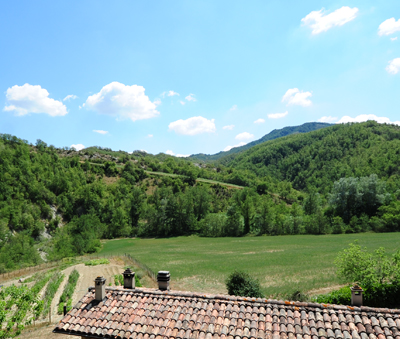
We left Earle-and-Suzanne’s this morning and drove to La Tavola Marche. It’s a combination agriturismo, cooking school and mountain retreat. We showed up around 12:30 and we got settled in. We’re on the top floor. Our apartment is very nice, very roomy. After we had unloaded everything, especially the food, we had lunch and headed over to the pool. It was so nice to just sit in the sun and when it got too hot, jump into the cool water.

The image is the mountains outside our kitchen window – a very different landscape from the Valley of the Metauro in Fossombrone. (Ashley told us that the top of the mountain is really Umbria.) We are in the south-western section of Le Marche. The area around the farmhouse is void of human traffic. The only things you hear are the cicadas, and the other guests at the pool. And if the guests are taking their afternoon nap then the place is silent.
In order to get Internet, we have to go down to Piobbico, a ten minute drive down a dirt road. My strategy this week is to do all the Photoshop and writing off-line and copy and upload everything when we are in town. (Piobbico is the town where they have the Ugliest Man and Woman festival.)
It’s 6:18 pm. I’m sitting outside at the Cafe del Corso in Piobicco, eating a cooffee granita and finishing this posting.
Rose took a picture of the old man, blogging. Once she sends it, I’ll post it.
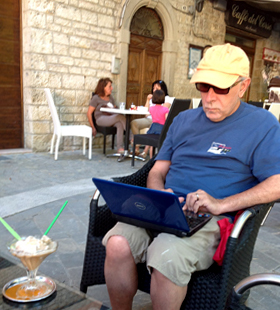
If it were up to me this is the kind of pic that would never see the light of day, but it’s a record. I’m sitting in Piobicco and that is a coffee granita in front of me. And for those truly observant anal retentive friends – yes, I’ve shaved the beard. (Another reason to bury the pic in some directory where it would never be found.)

All the foreigners come here to get Internet access. It’s mainly Dutch and German tourists. They flock here because of the hiking.
After we finish with our online fix, we are heading back to La Tavola Marche and will figure out what to have for supper.
Decided to add to this entry, because I always like to fill up the space around the pics. Yesterday and today, I prepared everything before we come down to Piobbico and then sent it up to the journal while at the Cafe del Corso. I think that writing the entries ahead of time has resulted in text almost free of tension. I’ve been leaving out the edge. An edge, a sarcastic voice that had found its way in as I sat, leisurely reviewing the day.
Today at Cafe del Corso there are more locals than foreigners. The three of us are the only ones sitting together, but not talking. We are busy with our various devices. The Italians around us are all yaking away. (There’s lots of complaining about various family members.) Tonight’s crew is older and probably on a passegata before heading home to the Sunday light meal.
My mandatory drink tonight is a cold chocolate. Still not great, but better than last night’s. Buy something and get Internet connection. Not a bad deal.
BTW, I was telling Rose that I get most of my protein from cheese and she was surprised and had to look up the protein value of milk products.

I love being in the mountains. (Earle-and-Suzanne’s is urban compared to where we are this week.)
This morning I walked down the road and there were all the farms that dot the valley. Came back and started shooting the sunflowers – le girasole – on the property. And the bees … (It was really the dark, dark blue.) There are hives on all the farms we pass, and now I know where the bees end up. Also, found that the plants that look like corn are pig corn. It grows nothing like American, genetically modified corn. The pig corn grows a single cob, a plume at the top of the leaves, with no husk. Here corn has always been something farmers feed the animals. Humans do not eat corn-on-the-cobs in Italy. But, there’s a whole food culture in northern Italy based on polenta – a mush made from corn flour – as the staple.

Today we decided to explore Sant’Angelo in Vado. We expected a back-water town and it turned out to be a great little town. We got there after Mass let out and it was teeming with locals.
To get there we literally went up and over the mountain. The road is this twisty, steep slope heading forever down. The name is Saint Angelo in the Valley. Guess we had to get down the mountain and into the valley. When we got there, we followed the town people into the Cathedral. (I didn’t take pics. There were too many of the faithful still milling around.
We found a store and bought dinner – roasted rabbit in wild fennel and garlic, stuffed zucchini, eggplant and peppers.
We left Sant’Angelo in Vado and did not want to go back up the mountain road, so we headed into Umbria and the provincial roads. We might as well have gone back up the mountain. We traded one mountain for another and headed down the next steep incline into another valley. (The speed limit is 70 km/h. I don’t know how they do it on the mountain roads. Even the bikes are racing the roads. BTW, everyone here wears helmets. There are signs everywhere reminding drives of the dangers of not wearing a helmet. Too bad Americans put machismo ahead of safety. But then they aren’t driving the mountain roads of Italy.)
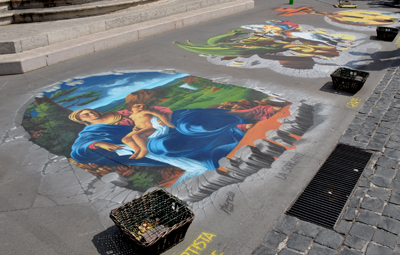
Today we drove across Le Marche and then south to Loreto, the city of the holy house. (Supposedly, angels carried the house that Mary lived in from Palestine and deposited in Loreto.)
The Basilica is this huge structure with a square in front. The square is surrounded by porticos. One side is the Apostolic Palace – Church offices on the piazza level, Church residences on the second floor. These are grand residences that are now a museum and it’s clear that the Church officials who lived in these rooms were nobility. There is no poverty here.
A young man was painting these chalk-drawings on the floor of the piazza. He had three baskets for donations under each. (Hey, if Mother Church can collect from all the pilgrims that flock here, why can’t he?)
Loreto attempts to do the same thing that Assisi does – create a destination for pilgrims. The difference between the two locations stares you in the face. Where Assisi has historical significance – the birth place of Francesco di Bernardone – and artistic significance – Giotto’s famous frescoes line the walls of the Cathedral; Loreto is fictional Catholicism. The Church made up this place.
Inside of the Cathedral, behind the main altar is this four-sided, open box of marble, beautifully decorated with carvings and reliefs. This external box is amazing in its complexity and artistry. The inside is lined with rock – supposedly from Palestine – but open to the dome. The ceiling is early Signorelli. In Orvieto, we see the mature master depicting the Apocalypse with its avenging angels assigning the locals their place in a tableau of eternal-rest. (In Loreto the avenging angel is in grey armor. In Orvieto he’s gloriously naked. In Loreto he’s a two meters tall controller, in Orvieto he’s a 10 meters tall beautiful avenger, the central figure in the tableau.)

It’s hard to walk through this box and think of the young Palestinian woman who was supposed to have lived here. There are frescoes on the stone walls, frescoes of angels. (Judaism does not depict heavenly creatures. The frescoes are Italian in execution and culture.) There is a marble altar in front of the back wall. There are gold candle holders on the marble altar. And the stones look like they could have come from any quarry in the area. And there are small niches with other gold ornaments. It’s absolutely clear that this whole complex was created and given meaning by some Church official. There is no theological, archeological, or religious base for anything here. It was created as a place that would attract pilgrims, that would attract pilgrim money. It is extremely successful. Four million pilgrims a year journey to Loreto.
I always understood Martin Luther on an intellectual level. After being in Loreto, I understand him on a gut level. Seeing the Disneyland house and realizing it’s a for-profit operation, makes Martin Luther a visionary, a prophet that the Catholic Church could not accept or learn from. And like all true prophets, he was persecuted and ostracized.
Oh, BTW, the Madonna of Loreto is a black Madonna.
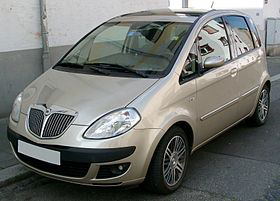
Last night I drove from the agriturismo into Piobbico on my own. It was my first time driving the rent-a-car. (It’s only registered in Derrick’s name.) I was cautious and wanted to get back before sundown; I didn’t want to drive the unpaved country road in the dark.
BTW, the Musa is the Lancia rent-a-car. It’s a great small car. (Wish we had access to some of the small car models they have here.)
We come into town daily to check email and blog. (The agriturismo is in the mountains about 1,400 feet abovee sea-level and no Internet.) For some reason, tonight I could not get Internet access anywhere in the cafe. Even moved my seat to two different tables.
So after calling Leger, because I had a phone connection, I headed back.
I like driving in Italy, it’s never boring. (There’s not a straight road anywhere.) Yesterday we spend most of the day on either the Autostradra or the provincial roads. These are fast arteries on the plains or the side of the mountains. The road to and from the place we are staying at is unpaved and the dust clouds hide the car as we drive its ruts and shoulders.
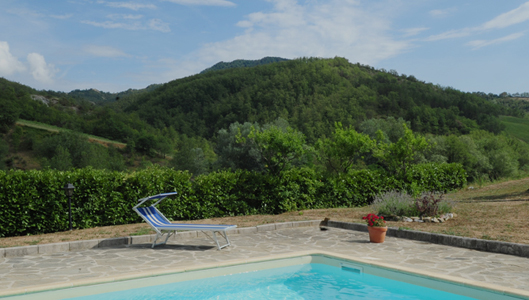
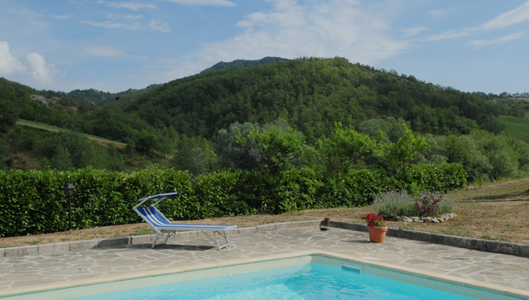 Today was a recoup. We went into Piobbico for the market and for coffee; and then headed back to La Tavola Marche to sit by the pool. (The Dutch family with its four, loud children left for the day; we had the pool to ourselves.)
Today was a recoup. We went into Piobbico for the market and for coffee; and then headed back to La Tavola Marche to sit by the pool. (The Dutch family with its four, loud children left for the day; we had the pool to ourselves.)
It is incongruous to be in the mountains of Le Marche and to sit by a pool full of clear, blue water. It’s Italian and American at the same time. (The two young owners of La Tavola Marche are Americans.) To add to the incongruity, the water in the pool is from a sulfur spring on the property, and every morning it’s treated to make it clear and sulfur free. And finally, Natalie Merchant is on my iPhone singing:
I do like being in the mountains. It really is the summer vacation of my youth. Many families in Aprigliano would go up to La Sila for the summer months. The mountains were their retreat from the summer heat. When she was a young woman, my mother went up with my grandfather, because he lived up in La Sila with the sheep during the summer months. My dad went up to La Sila to work, to hunt, to pick mushrooms. And even though I never went, I am of that generation most associated with my parents and their narrative became my early reference point. I just assumed sooner or later we would go up to La Sila during August. (Nah, we went to cold northern Ontario.) It’s with Connie that my parents’ narrative lost its meaning. She was two when we left Aprigliano. The narrative she heard was of her parents struggling to make a better life in Sault Ste Marie and how she would benefit from their struggle.
It takes a long time to situate oneself in a family continuum and age helps to figure out one’s placement in that family line. That awareness is faint during the time when we are building careers and families. (For me the awareness has come when those two accomplishments have been safely established.) Spending the last 8 summers here in Italy brings me into the continuum that is my family’s legacy to its oldest child.
The idea of going to the sea – al mare – during the summer is a modern protocol. I guess the way we know we are old and the mantle has passed is when the next generation begins to create its own routines. All my cousins in Aprigliano now talk about il mare throughout the summer. They send me pictures of them sitting in the maze of beach-chairs and umbrellas along the Mediterranean coast. I try and explain to my parents that they are on holiday, but the idea is not something they can associate with Calabria. For them, the beach in the summer is an American experience. (Last night we talked to them, and I kept telling Rose to just say that we are in a place like La Sila. As soon as they heard that reference they knew exactly what the area we are in looks like.)
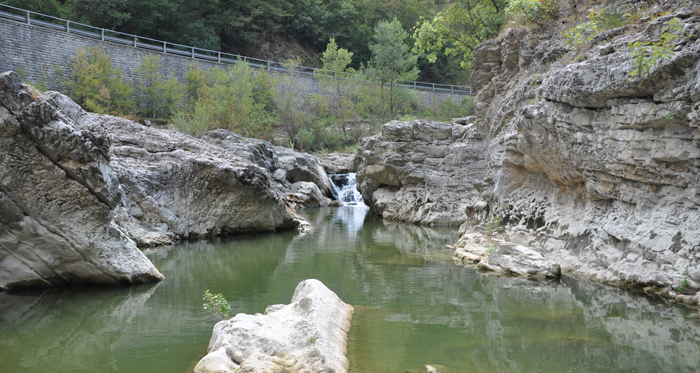
Today is that magical holiday in Italy where everything is supposed to be closed and everyone is away on vacation. (It’s the feast of the Assumption and the Italians are supposed to bee in church.) Since we’ve been coming, we’ve seen this tradition change. This morning all the cafes, on the street are open and I’m sitting in Crazy Bar, with Internet access. (I have no idea why Italians think that using American names for their establishments is great PR.)
The first couple of days we just looked at all the locals down the street at the Crazy Bar. None of the tourists ventured down there. Well, given that Internet access was sporadic at the other location, I walked down, plopped myself among the old me and flipped open my laptop. They looked over and I said, Bongiorno without a trace of a foreign accent. They went back to their card-playing, I went back to blogging.
When we were in Cosenza, everything was closed for ferragosto. And given that Le Marche is similar to Calabria in its history with poverty and Church control, I’m pleasantly surprised to find that the marchegiani seem to have thrown off the shackles of Mother Church.
 Later we will head down to the river for a picnic. That will be our contribution to ferragosto. The tourists that come to this area of Le Marche spend their time trekking the trails around the river beds. (At this time of year, the rivers that in the spring are torrents are trickles of water. This makes the river-beds great trails to walk and explore and picnic along.)
Later we will head down to the river for a picnic. That will be our contribution to ferragosto. The tourists that come to this area of Le Marche spend their time trekking the trails around the river beds. (At this time of year, the rivers that in the spring are torrents are trickles of water. This makes the river-beds great trails to walk and explore and picnic along.)
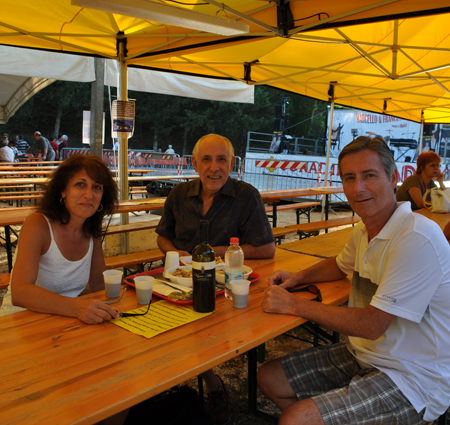
 Tonight, on ferragosto, we went to a Sagra del Polentone alla Carbonara in a small town – Cagli – between Piobbico and Aqualagna. (I hate polenta, and here I am going to a fish-fry type event that will serve nothing but polenta.) My mother and Leger will give me a very hard time about this. The sagra was in the parking lot of a Romanesque, country church – S. Maria A. di Naro, Chiesa Romanica, (sec. XI) – built in the eleventh century.
Tonight, on ferragosto, we went to a Sagra del Polentone alla Carbonara in a small town – Cagli – between Piobbico and Aqualagna. (I hate polenta, and here I am going to a fish-fry type event that will serve nothing but polenta.) My mother and Leger will give me a very hard time about this. The sagra was in the parking lot of a Romanesque, country church – S. Maria A. di Naro, Chiesa Romanica, (sec. XI) – built in the eleventh century.
Tables and tents were everywhere. We went early; the polenta was being made as we got there. And within 15 minutes we got our food. The carbonara sauce was super rich, so here I am eating a gelato to balance the grease. BTW, the cafe down the street from us has a DJ and he just finished playing Everybody is Talking at Me.
Tonight we will have a quiet evening and tomorrow we are going exploring the small towns around Fossombrone. We really like that part of Le Marche.
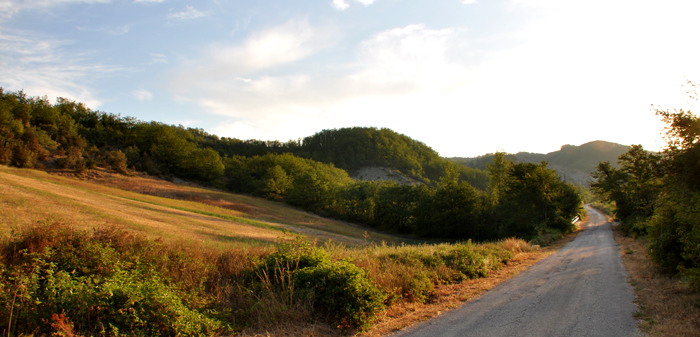
This morning I finally got up early and headed down the road for a walk. (There’s an abandoned cemetery and I wanted to go shoot it.) Mornings are amazing, the sun is just rising, so you don’t get the onslaught of the mid-day heat and the bugs are sleeping. The mountains at this time of day are silent. It’s taken me all these years to finally get into the mountains. (There are side-roads off the unpaved main road, but I didn’t have the proper clothes to trek up these paths.) The pig-corn is still a wonder for me. I’ve not see anything like it in America. (I’ll have to google it and Wikipedia it and see what comes up.) I also found a wide path down to the river – a tributary of the Candigliano which in turn is a tributary of the Metauro. However, the find of the morning was the cemetery. There are less than a dozen graves left. (Ashley said that all the people buried here are from the same farm-family up the road.)
The pig-corn is still a wonder for me. I’ve not see anything like it in America. (I’ll have to google it and Wikipedia it and see what comes up.) I also found a wide path down to the river – a tributary of the Candigliano which in turn is a tributary of the Metauro. However, the find of the morning was the cemetery. There are less than a dozen graves left. (Ashley said that all the people buried here are from the same farm-family up the road.)
The cemetery has a wall around it. The wall opposite the gate has the chamber that would have been used to keep coffins in the winter. The repository chamber is open, so I went in. Inside were all these wrought iron crosses, no two are the same. (In the cemetery in Aprigliano, I was amazed when I discovered all the different crosses that topped the small mausoleums. All were different.) These abandoned crosses are made to put into the ground as markers. Given that the whole left side of the courtyard is empty, these abandoned crosses must have come from that side. (It’s not uncommon in Italy to un-inter a coffin and re-bury it in a new, better, more prestigious location. (Most of my paternal grandmother’s family in Aprigliano, has been moved from the old cemetery in to the newer section. My mother told me that as soon as they build the above-ground crypts in the Soo, many Italian families un-interred their loved ones and placed them in the above ground crypts.) I suspect that many coffins were moved from this small mountain cemetery to the new cemetery in Piobbico. The only remaining graves are on the wall to the right of the chamber. These are the graves of the Gnucci family.
On my way back, I kept thinking that landscape can shape character just as much as family. Italy, except for the coastal plains and these are narrow strips, is a country of mountains. People live in these unique communities with mountain barriers separating them. (In Pittsburgh we talk a lot about the different neighborhoods and how the topography isolates communities and how these communities have developed distinctive personalities.) Well Italy is a whole county of such distinctive communities. No wonder it took forever to unite the country. It also explains the lack of national identity and the focus on local identity. (Pittsburgh too is famous for local identities and a lack of municipal consciousness.) Italy has been dealing with one other variable that only now America is recognizing – bad central government. The lack of trust in a central government, a by-product of living in isolated communities, has added to a strong township allegiance.
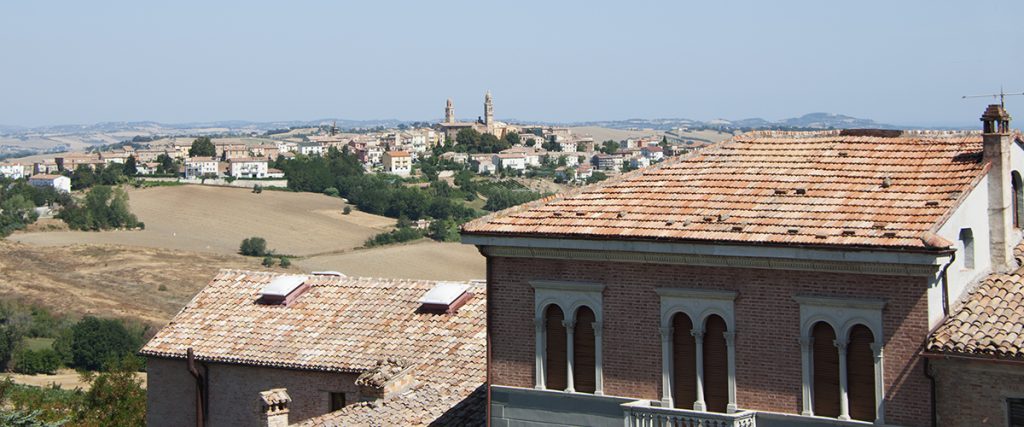

In the afternoon we drove to Mondavio and then Corinaldo. Corinaldo is the birth place of Maria Goretti. The only thing I remember about this saint is that she died rather than give up her virginity. (I remember a lot of jokes about her being the only Italian girl to say, “No.”) Well today got a different story, one that has me thinking that the Church in Le Marche has done some very unusual things – declaring that angels brought a house over from Palestine; declaring that a young girl from a migrant-workers’ family is a saint, because she put up a fight rather than give up her virginity to the landowner’s son. The son frustrated by of her refusal, stabbed her to death. But, before she died, she forgave her would-be-rapist.
The story continues – the son then goes up to Goretti’s mother – Mamma Assunta – and asks for her forgiveness. The mother tells him that since her daughter forgave him, he was forgiven. He then goes to live with a group of Franciscan monks, but never takes vows. Goretti is buried in the church of Santa Maria Goretti in Corinaldo in the crypt, her mother is buried on the left side of the nave and her would-be-rapist on the right side of the nave.
Now, my version of the story – The landowner’s son is the would-be-rapist that part of the story is consistent, but I suspect that his well-connected father went to the local Franciscan prior and made a deal. – “Declare Maria Goretti a saint, but let it be known that she forgave my son before dying. House my son in one of your monasteries and I will give a large donation. The Church gets a new saint from the peasant class, think of how many donations that will bring in; after all the villain is the landowner’s son, another plus in the class warfare propaganda the Church likes to traffic in, but don’t forget that she forgave him proving her worth to be a saint. Plus let’s not forget my sizable contribution.”
Nowhere in the story is law enforcement mentioned. And how is it that a migrant-worker’s family, who was as poor as dirt, can get through the bureaucracy that is the Roman Catholic Church to get their daughter proclaimed a saint. Nah, there were other more powerful forces at work. And for me those are the rich landowner, the Franciscans, and the local law enforcement. All had to agree on the plan and all had to get something from it – a win-win situation – in order for it to work.
The Italians had a new saint. Le Marche had a second site to attract tourists with religious leanings who hopefully will put money into the offering boxes.
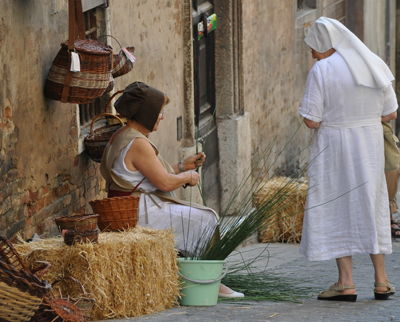
Today we headed up to Urbino. It’s my favorite place in Le Marche. It’s the Milan – modern, organized, clean and rich – of the province. The old centro is vibrant and well maintained. The surrounding suburbs are modern and development is controlled and well managed.
 The old city-center was full of bancarelle – vendor-booths to celebrate La Festa del Duca. We got there as the vendors were setting up. (All the stalls used bales of hay to mark their perimeters. Guess it’s to go with the medieval look.) In the evening more actors would be out participating in processions, jousting tournaments, theatrical performances and other dress-up events. (We didn’t stay for this part of the entertainment.)
The old city-center was full of bancarelle – vendor-booths to celebrate La Festa del Duca. We got there as the vendors were setting up. (All the stalls used bales of hay to mark their perimeters. Guess it’s to go with the medieval look.) In the evening more actors would be out participating in processions, jousting tournaments, theatrical performances and other dress-up events. (We didn’t stay for this part of the entertainment.)
The image above was too difficult to resist. (I did take it with the zoom, wasn’t sure it was polite to shoot it up close.) For me, it’s two medieval characters – one playing at dress-up, the other wearing her required uniform; one representing the merchant class of the Middle Ages, the other representing the corporation that ruled at the time. (In the future, will some men walk around in Armani suits when everyone else is wearing unisex spandex and riding segways or landspeeders? Will cities host Sagra di McDonalds or Bill Gates Festivals?)


Urbino’s palace culture gave rise to the first-ever painted images of utopian cities in the form of a trio of intriguing panels, all now known as “The Ideal City,” one of which remained in Urbino, the other two are in Baltimore and Berlin.
Years ago, I spent part of my junior-year at the Universita per Stranieri in Perugia. At that time Perugia was this sleepy, Umbrian hill-town in the middle of Italy. We lived with the locals. And Corso Vannucci – the main thorough-fare was full of local vendors who tolerated us. There was this great bakery/cafe that had the best pastries. The owner was this very masculine looking woman who ran the register. And after having our espresso or a granita-di-cafe, we had to get up the courage to go up and pay hoping that the she wouldn’t insult or berate us. (For the longest time, I pretended to not speak Italian because I didn’t want her telling me that I had a Calabrian accent. Il Mezzogiorno – the provinces south of Naples – were in great disfavor and looked down upon. I certainly didn’t want to be associated with them people.)
Perugia has changed radically since those long-ago days. All the local vendors are gone from Corso Vannucci. Guess Jeans, Armani, Starbucks and McDonalds now rent the store fronts. Urbino never went through this type of transformation. Instead it managed its transition into the modern world keeping the old centro in tack and economically viable for local vendors; its suburbs orderly; its new construction architecturally cohesive; and its university for Italians. It bills itself as la citta ideale – the ideal city.
Urbino never went through this type of transformation. Instead it managed its transition into the modern world keeping the old centro in tack and economically viable for local vendors; its suburbs orderly; its new construction architecturally cohesive; and its university for Italians. It bills itself as la citta ideale – the ideal city.
Everywhere in Urbino is an energy that you find in all growing, vibrant cities. The streets are free of filth; the medieval walls are pointed and cleaned; the old city is full of people; the cafes and bars cater to the locals rather than the tourists.
The above tag is from an exhibit – La città ideale, l’utopia del Rinascimento a Urbino tra Piero della Francesca e Raffaello – The ideal city. The Renaissance utopia in Urbino from the time of Piero della Francesca to Raphael.
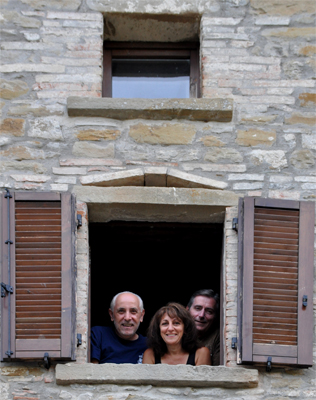
 We are leaving La Tavola Marche and heading to Bologna. I wanted that iconic “Italians in the window” shot, so I asked Ashley if she would take the pic. We are leaning out of the dining-room window looking down onto the courtyard, the outside dining space. (I need to explain the close-up feature of the camera. All the people that I asked to take our pic never zoomed in. Are they uncomfortable with the big camera?) Ours was their largest unit. We had two large bedrooms with en-suite baths and a nice sized living-dining-room/kitchen.
We are leaving La Tavola Marche and heading to Bologna. I wanted that iconic “Italians in the window” shot, so I asked Ashley if she would take the pic. We are leaning out of the dining-room window looking down onto the courtyard, the outside dining space. (I need to explain the close-up feature of the camera. All the people that I asked to take our pic never zoomed in. Are they uncomfortable with the big camera?) Ours was their largest unit. We had two large bedrooms with en-suite baths and a nice sized living-dining-room/kitchen.
I enjoyed our time in the mountains. It was a surprise to hear nothing but the whirring of the cicadas. And I like my attic room with its tall ceilings, beams-and-slats, wooden shutters. (It reminded me of our house in Calabria, me lying awake in bed looking up at the ceiling. And the twin beds certainly stirred the old synapse awake.) The shutters stayed shut all day to keep out the blistering sun, but at night I kept them partially opened to let in the cool night breezes. (I really liked the mechanism that, when open, kept them flush with the outside walls.)
According to Ashley, the third floor was where the family, that owned the house, lived. I find that odd, because the more common arrangement is that the animals are housed on the first floor and the family lives on the second floor. (The only thing I can think of is that it’s a huge house and may have had more than one family living in it. And that the owners chose to live as far away as possible from the smell of the animals.)
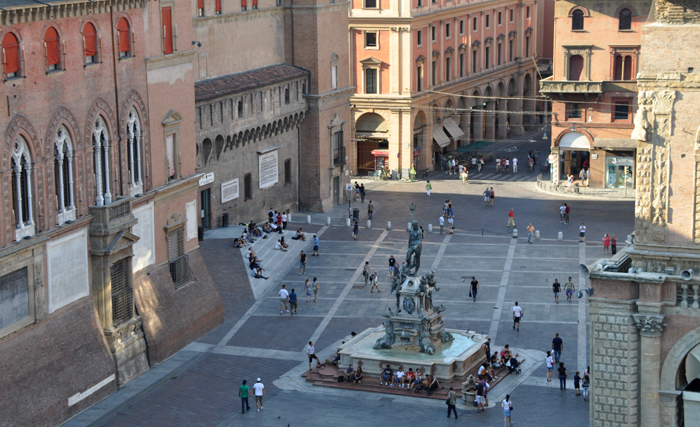
We flew into Bologna thinking that it would be a shorter ride to Fossombrone than driving from Rome. Distance wise it is shorter, but we totally forgot about ferragosto and beach traffic. Two weeks ago, it took us four hours to get to Earle-and-Suzanne’s and today it took us five hours to get back to Bologna. This time we hit all the traffic going home after the August 15 holiday. (It should have been a 2 hour drive.)
We also flew into Bologna knowing that we would have a day there to walk around, visit our favorite restaurant, and visit our favorite cheese and salami store. (The food in the Emilia Romagna region is worth going out of one’s way for.) This time there was an added treat. They are repairing the weather damage to exterior of the cathedral and for 3 euros, you can climb the scaffolding to the top and see the city from on-high.
 The shot is of the Neptune Fountain in the north western section of the piazza.
The shot is of the Neptune Fountain in the north western section of the piazza.
The front of the cathedral has no fancy marble facade. The Reformation put an end to the steady stream of cash and the cathedral was left unfinished. It’s amazing to realize that the Reformation destroyed the economy that the Catholic Church had created. (It’s always presented as a theological threat and never explained as the trigger that ended the reign of a corporate giant. I guess Martin Luther didn’t believe in “too big to fail”.)
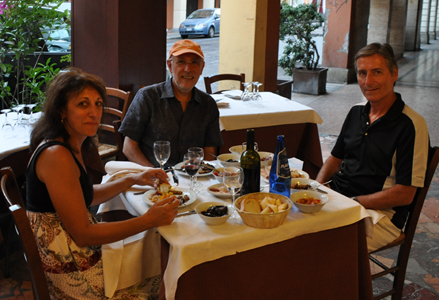
One of the main reasons we flew into and out of Bologna was because we wanted to eat at Ristorante Alice. We had eaten here three/four years ago and really liked it, so we were determined to get back to it. (I kept reminding Rose that the restaurant may not be there. After all, our favorite enoteca was gone. We resigned ourselves to that loss and had a glass of Sangiovese at a tourist joint.)
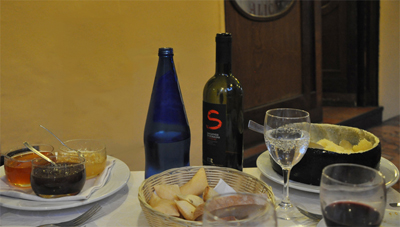
The things we remembered about ristorante alice were the antipasti, the wheel of cheese, and the pasta. Rose had kept the phone number, so I called and made reservations for 8:00. (Italians are just getting dressed to go out at 8:00, we were at the restaurant ready to eat. Whenever we go out to dinner, we are always the first to arrive.)
The restaurant is in the old city – via d’Azeglio – and its outside tables are under one of Bologna’s many porticos. The streets of the old city are lined with these beautiful and practical overhangs. Some are plain and some decorated with frescoes. However, all keep the sun off your head and the rain off your clothes. (In the area of town with Bulgari, Prada, Bottega Veneta, Armani, the porticoes are covered with frescoes.)
We began with the antipasti and the waiter brought out three – grilled zucchini, eggplant, and chick-peas in a balsamic reduction. We just kept smacking out lips and I complained about there being only three. Rose told me to just hold on and the rest would come out slowly. And they did. There was grilled zucchini, buffalo mozzarella, chickpeas in a balsamic reduction, grilled eggplant, roasted peppers, cabbage, dry sausage and prosciutto, roasted turkey with potato dumplings, Borlotti beans with tomatoes, and frittata topped with tomato sauce. We then decided to have a primi piatti, Derrick and I ordered the home-made fettuccini with porcini mushrooms. Rose ordered the ziti with a tomato sauce. She complained about the fact that once again she had missed out on getting the really good pasta. And she had. (The problem was that it was way too much food. I’m not used to eating three full meals a day. One thing about going home is that I will be able to get back to a more restrained eating regiment.)
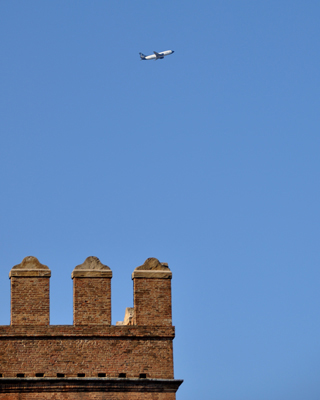
The read this series in chronological order,
click on the category title – le Marche-12 – on the right.
I’ve always wanted to steal lines from John Denver’s Leaving on a Jet Plane and I finally got the opportunity. (I took the shot from the scaffolding covering the front of the Bologna cathedral.)

At 4:30 in the morning even the tourist-packed, under-renovation airport in Bologna is empty. I was the second person through security.
The story of the return trip happened at the airport in Frankfurt. I was one of the first to board the US Airways flight to Philadelphia, so I’m sitting there across the tarmac from an EL AL plane. The entire ground around the plane was roped off and there was a police vehicle at each corner and an armed guard patrolling the perimeter. (The guard had an Uzi strapped across his chest.) Any airport worker coming into the roped-off area was frisked with a metal detector; the perimeter was so secure nothing was allowed to breach it without a full body inspection. There were two layers of security that workers had to maneuver around – the outside layer with the police cars and guards, the inner layer with about 10 supervisors. The police and guards kept people from coming in, the supervisors managed anyone inside the security zone. I don’t know if this is standard-operating-procedure for any and all EL AL planes, or if this only happens in Germany. (I’ve never been on the tarmac next to an Israeli plane before.) I watched for almost 45 minutes and all movements were scrutinized and recorded. Yes, the supervisors had clip boards and made marks every 10/15 minutes.
The trip home, compared to the trip there, was uneventful. (My conclusion is don’t book a trip that has me going through three different airports.)
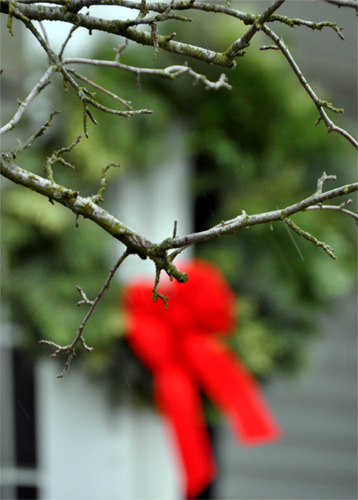
 I began the trip yesterday, hoping to get ahead of the storm, but where the drive was through flat Ohio corn-fields and gray skies; the severe weather was also moving west and got to Northern Michigan by the time I reached Oxford north of Detroit.
I began the trip yesterday, hoping to get ahead of the storm, but where the drive was through flat Ohio corn-fields and gray skies; the severe weather was also moving west and got to Northern Michigan by the time I reached Oxford north of Detroit.
There is a storm warning for Gaylord – the middle of the state, an I-75 corridor and a snow-belt area. The cameras for Michigan State Transportation show a snow-covered I-75 North in the Grayling/Gaylord area. (I’ve always wanted an opportunity to use those two names in a posting, guess it finally came along.)
So, I’ll stay at Rose-and-Derrick’s at least today. We’ll see what the roads look like tomorrow and decide if we’ll travel or wait till Saturday.
The image is of Rose-and-Derrick’s neighbor’s house. I couldn’t do a wreath and this was the next best thing – a blurred wreath in the background and bare branches in the foreground.
I’ve never tried to understand the gray-gloom of this time of year, mainly because I’ve always been focused on the long ride to Sault Ste Marie and getting there without hitting bad weather. But this year it seems that the gray-gloom was all-encompassing. Pittsburgh was cloud-covered and everything was a miserable-gray. And today, it’s raining and gloomy here in Southern Michigan. I finally figured out that the season begins with the gloom and end with the sun. No wonder Mother Church decided to re-structure the Roman Saturnalia and the coming of spring. (Whoever figured out to do Christmas in the gloom and Easter in the brightness of spring was a genius.)
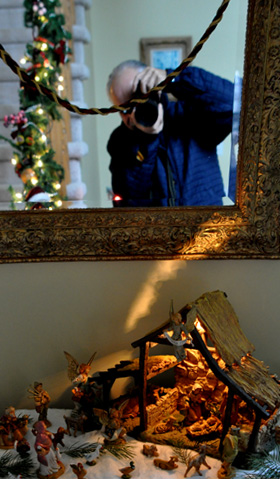
 The weather is really frightful; we are getting the rain-band of the storm. We’ve decided to stay in and enjoy the luxury of not having to go anywhere or do anything. And Sambuca makes doing nothing even more pleasant.
The weather is really frightful; we are getting the rain-band of the storm. We’ve decided to stay in and enjoy the luxury of not having to go anywhere or do anything. And Sambuca makes doing nothing even more pleasant.
The image is of the presepio on top of grandma’s old sewing machine, the stairs festooned in garland and me in the mirror with camera and quilted jacket. The presepio is an old world, Italian tradition we’ve all maintained. They’re no longer the hand-made, hand-painted, paper-mache, Neapolitan figurines, now they’re made in resin molds and colored in bland, faint earth-tones. (The Neapolitan angels drape the Christmas trees at The Metropolitan in NYC, The Carnegie in Oakland. And the mangers scenes, celebrating the poor of the world, spread out under these artificial evergreens.) My presepio was a gift from Jo’. One of her friends had gone to Italy and she got her to buy me my manger figures. (The one I assembled when we first came from Italy is at my parents. It’s figures are Neapolitan and paper-mache.)
Rose talked to both Mafalda, my mom and her mom – Mafalda’s sister and my aunt. Both understand the interference the weather has brought, but are confused about the fact that we just didn’t drive up. (My aunt mentioned that the schools were closed in the Soo, because of the weather. And yet we’re supposed to drive up and visit with them.)
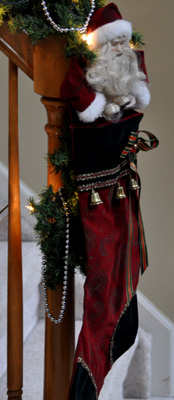
 We had a great supper – pasta with herbs flavored olive oil, salad and dessert. The dessert was wonderful. Derrick roasted chestnuts out on the grill, in the rain and I suggested we have the Visner di Pergola that they had brought back from Le Marche. The Visner is a sweet wine – wild cherries from the Macerata area blended with Sangiovese and Montepulciano wines. The wine gets its name from the wild cherries know as visciole. Throughout Le Marche families make their own version of Visner. And the quality varies just as the quality of the home-made wines we will soon drink up the Soo varies. (I’m curious to see what my dad’s wine will taste like this year. With him it’s always a surprise. My uncle is more consistent with his wine from year-to-year.)
We had a great supper – pasta with herbs flavored olive oil, salad and dessert. The dessert was wonderful. Derrick roasted chestnuts out on the grill, in the rain and I suggested we have the Visner di Pergola that they had brought back from Le Marche. The Visner is a sweet wine – wild cherries from the Macerata area blended with Sangiovese and Montepulciano wines. The wine gets its name from the wild cherries know as visciole. Throughout Le Marche families make their own version of Visner. And the quality varies just as the quality of the home-made wines we will soon drink up the Soo varies. (I’m curious to see what my dad’s wine will taste like this year. With him it’s always a surprise. My uncle is more consistent with his wine from year-to-year.)
Even though it has been a great day relaxing and not having to worry about driving, the news is all about the storm and the havoc it is wrecking across the mid-west. We may not leave until Saturday. By then it will have made its way through Michigan. Also, by Saturday, the Interstate should be in decent shape.
The image on the right is of a Christmas sock on Rose-and-Derrick newel-post.
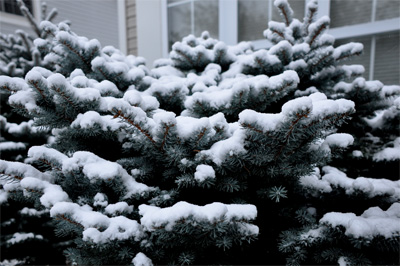
 The snow made it to this part of the Lower Peninsula. Detroit was spared, but we’re 70 miles north of the city.
The snow made it to this part of the Lower Peninsula. Detroit was spared, but we’re 70 miles north of the city.
Went outside to shoot some pics and it’s not all that cold, but you can feel the thin layer of ice on the concrete. After all it rained and rained all day yesterday.
The Michigan Department of Transportation’s camera still shows snow covered roads in the Grayling/Gaylord area. And the decision is to stay put one more day and to head up tomorrow. By then the storm will have moved out of the area and the roads should be in better shape.
Leger texted me to say that Boehner can’t get the votes he needs from his fellow Republicans to pass a Plan B bill. I know this makes me old, but I do remember the same thing happening to the Dems when their run was over. The country had changed and they were still running on a liberal agenda. (Nixon was the symbol of the change of the end, but the Dems wouldn’t look.) Well guess what, the country has changed again and the Republicans still thinks that white-men rule. (Obama is the new symbol and there is just as much cultural blindness now as there was 45 years ago.)
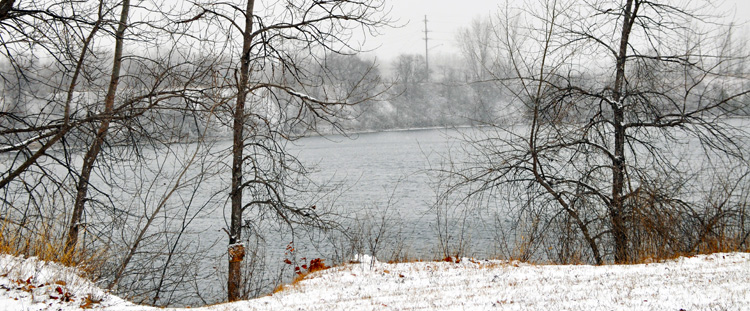
 The world is beginning to get back to a non-sullen routine – the skies are losing their gray pallor; the winds are running empty; the snows are drifting slowly; the reds and greens of the season are twinkling bright.
The world is beginning to get back to a non-sullen routine – the skies are losing their gray pallor; the winds are running empty; the snows are drifting slowly; the reds and greens of the season are twinkling bright.
My dad doesn’t like the fact that we’ve been stranded by the weather and readily expresses his displeasure. (Even Connie couldn’t leave for Toronto and the Thormans. All flights out of Sault Ste Marie were cancelled yesterday.) The storm was correctly named – Draco. (JK Rowling would be pleased to know that the characteristics she gave her fictional antagonist have also served to define the storm.) BTW, did I just mix my metaphors – The Lion the Witch and the Wardrobe, Harry Potter?
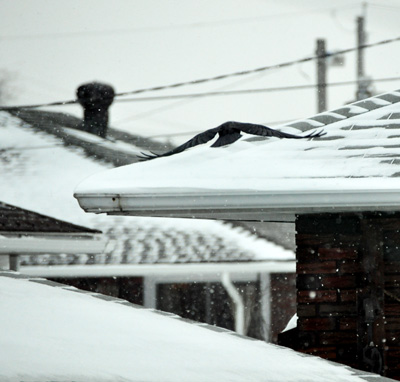
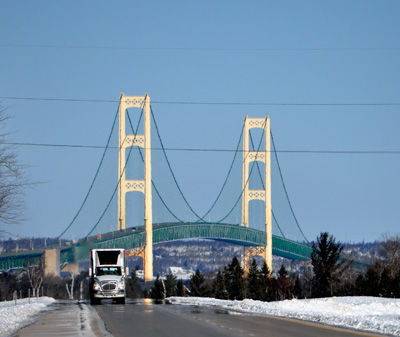 The drive north from Oxford was OK except in two places – 30 miles south of Gaylord and 30 miles before the Soo.
The drive north from Oxford was OK except in two places – 30 miles south of Gaylord and 30 miles before the Soo.
Gaylord is the center of the snow-belt, in Northern Michigan, and the trees surrounding the highway were amazingly beautiful in their snow covers. The winter landscape was worthy of a postcard. (Draco left behind a winter wonderland.) But all I kept thinking about was the snow storm – what it must have been like two days ago on this stretch.
After three hours of snow-free roads, I-75 became a problem. The right lane was covered with packed snow. Not a big problem given that it hadn’t iced, but the packed snow made it difficult to drive casually. Such conditions are two-hands-on-the-wheel-and-no-music driving events. All the cars got into the left lane and we followed each other down the highway like goslings following mother. And because the left lane was clear, we were able to maintain speed. After Gaylord, the road was clean and I thought, “If that is the worst I’m going to get then I’ll thank some higher power.”
There are certain markers that I use when making this trip, Gaylord is one; the sight of the south tower of the Mackinac Bridge is the other. (Once I hit the bridge, I have to steel myself for the crossing. The span is an engineering marvel and a magic string over the straits, but the roadbed and the low railings scare the shit out of me. The low railings and the missing road-shoulder make riding in the right lane feel like I can hurdle into the roaring waves at any minute. The left land is an open metal grid – supposedly the grid allows for wind currents and thus stabilizes the Mighty Mac. But riding on the inside lane is nerve-racking and feels like the car will slip and slide. But that sensation is easier to deal with than the fear of being hurled over the side, so I drive the inside lane. Throughout the ordeal, I keep telling myself that the trip is coming to an end.) Once I crossed into the Upper Peninsula the road was a mess. The north bound lanes were not clean and I drove the last 30 miles on packed snow. I just kept looking for the steel mill smoke stacks. I-75 ends at the International Bridge over the St. Mary’s river, the boundary between the U.S. and Canada. On the Canadian side of the river is the steel mill.
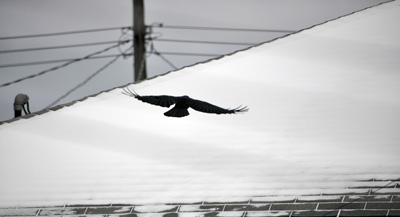
 My favorite room in my parents’ house is the sun-room. It faces the garden and its windows are always curtain-free. It’s also the view that has the most memories.
My favorite room in my parents’ house is the sun-room. It faces the garden and its windows are always curtain-free. It’s also the view that has the most memories.
Behind my parents’ garden is the Coccimiglio’s house. Giselle Coccimiglio was the beauty of my generation. (She was the classic Italian young woman with beautiful long black trusses.) And like all the immigrant daughters was very restricted in who she could talk to and who she could socialize with. (I remember thinking that her parents were more like my grandparents in their over-protectedness.) Giselle was not allowed to socialize with anyone in her class. (Frank, she and I were all in grade 8 at St. Veronica’s.) My mother would tell me about all the kids I had grown up with and she told me that Giselle married some older Italian man that her family selected. Giselle died young of breast cancer.
To the right of Coccimiglio’s is Colleen’s family’s house. We played softball in the field behind Colleen’s house. She was the only girl to play with all us immigrant boys – Frank, Rainer, Ron, Jackie, Mike, Joe, Carlo. And everyone wanted her on their team, not because she was attractive, but because she was the best ball player in the neighborhood. Even Ron with his natural athleticism and fluidity couldn’t hit as far as Colleen. Every time she was up to bat, all the fielders would move back to the road knowing they had to prevent a home run. (I don’t remember any of us caring that she was a girl and could hit and run better than us.)
Next door is Concetta Sirianni’s house. She is this gregarious woman full of bawdy language and extreme opinions. And a welcome breath of fresh air into a very proper Calabrese family. (The two Perri sisters come from families that prided themselves in a sense of propriety. A propriety that set them apart. Afterall their mother came from a family of small business people – lace makers – and their father had made it to l’America and prospered there.) Mafalda told me that Concetta has “buried two husbands” and is now involved with a social group of widows and widowers and having a great time. Mafalda wonders if she’ll find a third husband.
Sitting here drinking my morning espresso, three crows flew into the yard. (I associate crows with winter. It seems I only see them during that time of year.) I quickly got my camera and started shooting. The crow is flying away lighting over the Coccimiglio’s house.
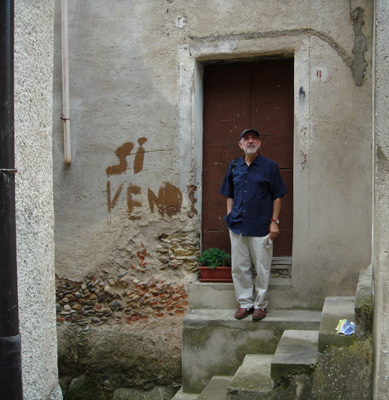
Today I sat down with Mafalda to ask about the Perri family’s geneology.
My grandfather was one of six children – Assunta, Eugenio (my grandfather), Gulia, Emilia, Stefano and Concetta. My great-grandparents were Angelo Perri and Luisa Carbone.
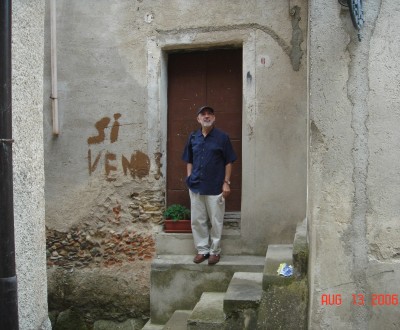
The brothers
The family story is that my grandfather – Eugenio – came to Canada and sent money back to the family in Calabria. My great-grandmother supposedly used the money as dowry for the girls and to purchase a house in Corte. (My great-grandparents raised their family in one of the torre in the hills surrounding Aprigliano. And with my grandfather’s money, they left the country-house and moved into town. The pic on the right is me standing in front of the house that my great-grandparents lived in.) But when my great-grandmother died, my great-grandfather went to live with his son Stefano and gave Stefano the house deed, even though it had been purchased with money his brother, my grandfather, had sent from Canada. (My grandfather believed that his mother had saved the money he had sent and that he could return to Calabria and make a living using his savings to buy land. Instead, when he returned he found that all the money had been spent. He packed up and returned to Canada.)
When my parents married, Mafalda’s uncle Stefano rented them the house in Corte. I was born in that house. (Mafalda tells the story that she and my dad had missed one of the rent payments – 700 lira a month – because times were hard. Her uncle Stefano came over with his shotgun and told her that if they missed any other payment, he would use the gun on them. Mafalda was outraged, because this was the house her father’s money had purchased.) I never knew that the house in Corte had been the Perri family house in town.
My great-uncle Stefano died at work. He fell while he was pruning on olive tree and the fall killed him.
The sisters
Assunta was the oldest of the Perri children. She married Eugenio Vigna and there were 6 children.
Gulia married Giovanni De Fazio. She died young and left behind 5 children.
Emilia married Luigi Carbone and they had three children. I visit with one of those children – Maria Lucente when I go to Aprigliano. Maria bought the old Perri house where my parents first lived and where I was born. She incorporated the old Perri house into her house.
Concetta married Peppino Giordano and moved to Pietrafitta the next main town on the SS178 after Aprigliano. (Mafalda remembers the least about this aunt.)
Connections
Za Nuziata is related to us through her grandmother. Her grandmother Rosaria Perri and my great-grandfather were brother and sister.
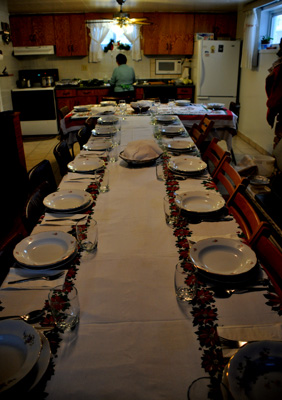
 Let me begin with Christmas Eve. We always go to my aunt-and-uncle’s for this meal. (Years ago, they agreed that for one family to host both the Christmas Eve and the Christmas Day meal was not fair or practical, so the two days got split between my aunt’s family and my family.)
Let me begin with Christmas Eve. We always go to my aunt-and-uncle’s for this meal. (Years ago, they agreed that for one family to host both the Christmas Eve and the Christmas Day meal was not fair or practical, so the two days got split between my aunt’s family and my family.)
My favorite dish is the spaghetti dressed with olive oil and anchovies. The other pasta option is a red sauce flavored with calamari. (They still follow the old Catholic tradition of no meat dishes on Christmas Eve.) The white spaghetti with the anchovies is for the 4 remaining Apriglianesi – Egilia, Mafalda, Ciccio and Mario. My uncle and his step-mother are from Martirano and don’t eat the white spaghetti. Rose and Derrick follow the Martirani and use only the red sauce with the calamari on their pasta.
My uncle always has some surprise at this meal. This year it was Strega – a yellow herbal liqueur from Campania.(He pointed out that this particular bottle was direct from Italy and not purchased in Canada.)
This led to talking about the process that one had to go through to buy any alcohol product in Ontario. I remember the Liquor Control Board (LCB) store on Albert Street. It was lined with shallow shelves and above the shelves were pictures of the various products you could buy. The customer filled out a card with the product name and its number and took the slip up to the counter. One of the agents would go into the back and bring out your product. And my favorite product was a liqueur called Millefiori. It too was a yellow liquid, but inside the bottle was a branch and the branch was coved in sugar icing, clear sugar icing. It was a beautiful presentation. (I’ve been looking for a bottle for years with no luck. Rose said that she had also looked in Italy and was told the company no longer make the product.) My uncle claimed that Strega has a similar taste. I didn’t know Strega, so he rummaged around in his “bar” and brought out a bottle purchased in Italy not at the LCB, and we opened it and had a drink. It does taste similar to Millefiori just not as sweet. But then there isn’t a branch covered is sugar inside the bottle.
Today the meal is at my parents’ and we’re expecting a minimum of 20. And Ciccio has been cooking since this morning at 6:00. Right now the two old people are in the downstairs kitchen arguing about how many will be for dinner. (I had lunch; yelled at them for arguing with each other; (The argument was whether Ciccio should break open his 5-year-old barrel of wine. Mafalda claiming that this was a good occasion, Ciccio claiming that he had no empty bottles to transfer the old wine into.); I left them to their own devices and came upstairs to do this entry. I guess at 85 and 86 arguing may be healthy.)
There will be two distinct meals – an Italian set of dishes and a Canadian set. The Italian foods include capelletti in a chicken broth, lasagna, and various greens – rapini, broccoli, and salad. The Canadian foods include fried shrimp, fried clams, turkey, stuffing, and mashed potatoes. I eat the Italian stuff.
The pic is of the tables in the downstairs kitchen. My mother is at the sink preparing some food.
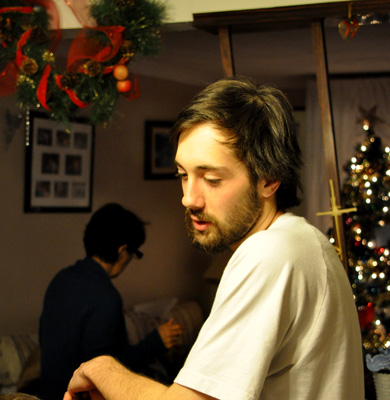
 At dinner my dad got sick, because he ate a bad clam. (I never eat their non-Italian food. I believe they should stick to the foods they are familiar with, but then they wouldn’t be Canadian; they would still be immigrants. And in this family the tension between the two cultures is always a fine line that all of us tread.)
At dinner my dad got sick, because he ate a bad clam. (I never eat their non-Italian food. I believe they should stick to the foods they are familiar with, but then they wouldn’t be Canadian; they would still be immigrants. And in this family the tension between the two cultures is always a fine line that all of us tread.)
Last night, my dad was going on and on about his cousins who spent Christmas Eve at home rather than join their children at a restaurant. Ciccio was outraged at this break – going out to eat on Christmas Eve rather than cook and host all the family – with tradition. I kept saying that it was OK given how much work it was to host a large family gathering.
The bad clam incident led to a memory dump of all the other times that Ciccio inflicted his experiences on the rest of us at Christmas…
There was the time that the neighbors came to wish everyone a Merry Christmas and Ciccio visited with them. They came just as we were getting ready to sit down to eat. The visit got extended and we all left the table hoping that they would get the hint, but Nah, they stayed with Ciccio for at least another 45 minutes. By the time we ate the food was cold.
There was the time when the chimney caught fire just as we were sitting down to eat and Ciccio decided to go on the roof with the hose and sending water down the chimney that was shooting out sparks. The fire department came, made sure there was no chance of fire and left. We all went back in to eat.
The pic is of Christian, with his aunt Connie in the background. He’s sporting a beard. (Connie claims he looks like his nonno when Ciccio was young.)
Connie gave me a new red espresso pot. It will add color to my kitchen.
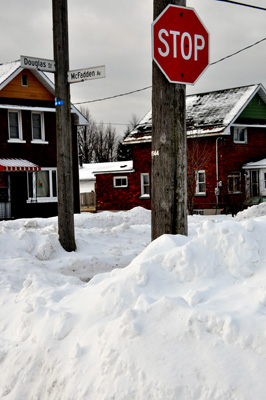
 The British live on in Canada – today is Boxing Day. (By the time I got up, Ciccio had taken down the two extra tables and set them by the stairs. I got Christian and Clay to take them back out to the garage.)
The British live on in Canada – today is Boxing Day. (By the time I got up, Ciccio had taken down the two extra tables and set them by the stairs. I got Christian and Clay to take them back out to the garage.)
Because the sun was out, I decided to take a walk to St. Veronica School. (It’s funny how my one year at St. Veronica’s – 8th grade – is a stronger memory than any of other elementary school experience.) I followed the route I used when going to school in the winter of 1964. In the fall, I would go through the wooded lot between Douglas Street and the school then known as the bush, but in the winter I would use the streets.
The pic is of the corner of Douglas Street and McFadden Avenue. Ron lived on Douglas, in the house on the right. (Much of the housing stock that was there in 1964 is still there. Newer houses fill in the lots that were empty back then.) Growing up, Ron’s house was the place we would all hang out at. It was where we would meet in the morning to decide what we were going to do. Frank lived at the end of McFadden.
I didn’t crop the image, because I wanted to show the snow. The banks were easily 5/6 feet high.
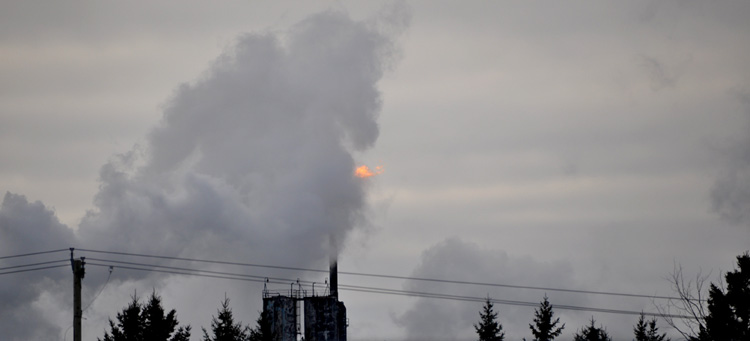
By 10:30 I was on my way home. I drove the first half today and tomorrow will head east to Pittsburgh. The Customs’ agent was this really nice person and we talked about how I became an American citizen. (Going through Customs is usually an ugly experience.) Getting through Customs is the first step home and crossing The Mac is the second.
I’m trying to figure out how to situate this last post and I decided to play with the idea of memory.
 I went out for an early walk, my last before leaving for another year and I was coming down McFadden and there, on the horizon above the pine trees, was the symbol of 1950’s Sault Ste Marie – huge black chimneys bellowing white smoke and narrow chrome chimneys spouting open flames.
I went out for an early walk, my last before leaving for another year and I was coming down McFadden and there, on the horizon above the pine trees, was the symbol of 1950’s Sault Ste Marie – huge black chimneys bellowing white smoke and narrow chrome chimneys spouting open flames.
My family came to this northern outpost, because in the late 50’s, after the war, Canada was building its industrial base and recruited laborers in the devastated cities and towns of post-war Italy. It almost emptied out Calabria. There are more Calabrese in Southern Ontario than there are in Calabria today.
The Canada of the late 1950’s and the 1960’s was a nation on the move – new roads, new airports, new cities, new suburbs, new universities, new museums. The immigrants, who crossed the Atlantic, saw it as the land of hope, the land of work. My dad worked at the mill and made a living for his family. All his children got a university education and the opportunity to make a good life. (While in college, I went home for the summers and worked in the mill. Made enough money to pay my next year’s expenses. That’s how I paid for Junior-Year-Abroad.)
But modern-day Canada is selling its natural resources to the highest bitter. In July, the Wall Street Journal reported:
Cnooc Ltd. swept into Canada with China’s biggest overseas acquisition yet, a $15.1 billion deal to buy one of that country’s largest energy producers that reignites a debate over the role of Chinese state players in North America’s energy industry.
If completed, the deal for Canada’s Nexen Inc., would mark China’s most ambitious push into the continent’s oil and natural-gas fields. It would give Cnooc a key role in technologies reshaping the energy landscape and open the door for it to operate in North American fields alongside such oil-and-gas giants as Exxon Mobil Corp. and Statoil ASA.
The entire article can be found at: China Push in Canada Is Biggest Foreign Buy
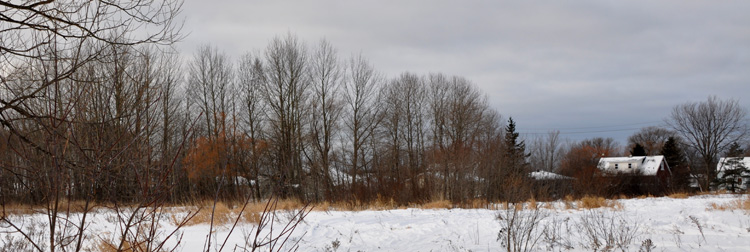
To read this series in chronological order,
click on the category title – Christmas-12.
The drive from Oxford to Pittsburgh has a couple of unpleasant spots, but it also has the pastoral Ohio Turnpike.

The first tension-step is getting on I-75 South. This morning traffic was light and getting on was easy. Two or three miles down there was an accident and a long backup, but I got through it quite quickly. The next tension-spot is the exit towards Toledo. (It’s actually the continuation of I-75 South but it veers west away from downtown Detroit.) From the exit and until you enter Ohio, I-75 is miserable. The landscape is Blade Runnerish. I-75 through south-east Michigan is an ugly environment and the section south of Detroit the worst. The run through the Marathon Oil Refinery area is surreal. (I hope replicants run the machinery?) When I see the Welcome to Ohio sign it’s a relief. I’m out of Michigan.
I-75 through Ohio is beautifully landscaped and the Cable Stayed bridge in Toledo is elegant. Next is 280-South a connector to the Ohio Turnpike. Going through the gate at Entrance 155 and heading east is another marker on the road home. The Ohio Turnpike is really well designed. Huge cement walls separate the east and west bound lanes, and the service centers are new and very modern. The topography undulates through corn-fields and today they were white with December snow.

On Friday, November 22, 1963, I was sitting in my 8th grade classroom at St. Veronica’s when Sister Drusilla came in to announce that the president of the United States had been shot. This was the Catholic president of the United States and as a Catholic Canadian the news was shocking.
 It was my first year at St. Veronica’s. (My family had bought a house in the West-end; we had left my grandparents’ to live on our own.) The classroom, compared to the one I came from, was old fashioned. We had wooden desks with holes in the upper right hand corner for ink-wells. And filling them was the jobs of the “good” kids. There was a piano in the room and Sister Drusilla taught us to sing while sitting on its long bench. (Our music book had Santa Lucia in it. Well, the English version of the Neapolitan song.) Above the piano was a bulletin board and Frank’s birdhouses, that he build for his Science project, hung there. That Friday, we had one of the itinerant teachers and Sister Drusilla kept coming in from her office to give us the latest news on the President. When she came in to tell us that he had died, I remember looking up at the black-framed, round, analogue clock and saw that it was a-quarter-to-four. (In those days no one said, 3:45.) Sister Drusilla’s announcement seemed to suggest that even though one of our own had finally made it, they had killed him. Was she suggesting that the American president was like Jesus?
It was my first year at St. Veronica’s. (My family had bought a house in the West-end; we had left my grandparents’ to live on our own.) The classroom, compared to the one I came from, was old fashioned. We had wooden desks with holes in the upper right hand corner for ink-wells. And filling them was the jobs of the “good” kids. There was a piano in the room and Sister Drusilla taught us to sing while sitting on its long bench. (Our music book had Santa Lucia in it. Well, the English version of the Neapolitan song.) Above the piano was a bulletin board and Frank’s birdhouses, that he build for his Science project, hung there. That Friday, we had one of the itinerant teachers and Sister Drusilla kept coming in from her office to give us the latest news on the President. When she came in to tell us that he had died, I remember looking up at the black-framed, round, analogue clock and saw that it was a-quarter-to-four. (In those days no one said, 3:45.) Sister Drusilla’s announcement seemed to suggest that even though one of our own had finally made it, they had killed him. Was she suggesting that the American president was like Jesus?
Frank and I went home that afternoon confused by the day’s events, but knowing something important had happened. And even though we lived in a small town in Northern Ontario, we were somehow part of it.
Five years later, I would leave Sault Ste Marie and Canada forever and make my way to the land of President Kennedy, to a more congenial spot for happily-ever-aftering.
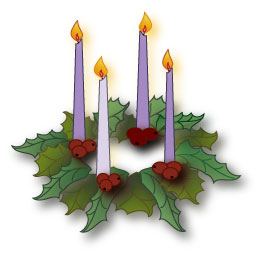
The date of the first Sunday of Advent of 1963 was December 1. Fifty years later, the first Sunday of Advent again falls on December 1.
I’m beginning the christmas 2013 posts early, because I’m going to organize them differently. I’m linking these posts to the 8th grade category, because I want to wrap them around some memories of nineteen-sixty-three.
December 1963
We had moved to the west-end in June and this was my first Christmas at St. Veronica’s. I was curious to see how it would go, because for the first time I had a nun teacher. Was she going to deal with Advent differently than all the non-religious teachers I had had?
 The Monday of the first week of Advent, Sister Drusilla lined us up in the hallway – the upper grades were in the old hallway and the younger kids were in the hallway leading to the new wing – and with the sign-of-the-cross she began the Advent service. The young nun who taught first grade picked up from Sister Drusilla reciting the Advent prayers and readings. It ended with us singing O Come, O Come Emmanuel. I liked the Advent service. We certainly didn’t do anything like this at St. Theresa’s.
The Monday of the first week of Advent, Sister Drusilla lined us up in the hallway – the upper grades were in the old hallway and the younger kids were in the hallway leading to the new wing – and with the sign-of-the-cross she began the Advent service. The young nun who taught first grade picked up from Sister Drusilla reciting the Advent prayers and readings. It ended with us singing O Come, O Come Emmanuel. I liked the Advent service. We certainly didn’t do anything like this at St. Theresa’s.
The time before Christmas was full of anticipation and even though I knew all about Liturgical Advent, it never seemed real hearing about it only on Sunday at church. We did not have an Advent wreath at church, but having the service at school with the wreath on a small table in the hallway with candles that Sister let a kid light, made the season of Advent real.
(For the image, I wanted something that was both modern and non-realistic.)


| Old Calabrese | Modern Italian | Dates and Feast-days |
| u quàttru Barbara | il quattro Barbara | December 4 – St. Barbara |
| u sie Nicola | il sei Nicola | December 6 – St. Nicholas |
| u òttu Maria | l’otto Maria | December 8 – Immaculate Conception |
| u tridici Lucia | il tredici Lucia | December 13 – St. Lucy |
| e lu vinticinque lu Missìa | e il venticinque il Messia | December 2 – Birth of the Messiah |
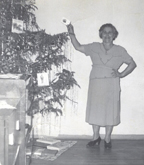 When we first got to Sault Ste Marie, my grandmother whose her image is on the left, taught me this rhyme and I remember thinking it was a fun way of marking off the days until Christmas. But as the years went by, I forgot the last part and could only remembered the first couple of lines. I’ve been trying to find the rhyme online, but have had no success. Finally, I took a chance and wrote it phonetically, in Old Calabrese, into the Google search-box and found it posted by Francesco Pecora on his Facebook page. Francesco lives in Polistena a small town in south eastern Calabria.
When we first got to Sault Ste Marie, my grandmother whose her image is on the left, taught me this rhyme and I remember thinking it was a fun way of marking off the days until Christmas. But as the years went by, I forgot the last part and could only remembered the first couple of lines. I’ve been trying to find the rhyme online, but have had no success. Finally, I took a chance and wrote it phonetically, in Old Calabrese, into the Google search-box and found it posted by Francesco Pecora on his Facebook page. Francesco lives in Polistena a small town in south eastern Calabria.
Below is his text:
Il detto descrive il modo con cui i nostri antenati annunciavano le feste nel periodo dell’Avvento; Il 30 Novembre, infatti, si festeggia S. Andrea Apostolo, che introduce le festività di: Santa Barbara (4 Dicembre), San Nicola (6 Dicembre), l’Immacolata (8 Dicembre), Santa Lucia (13 Dicembre) e il Santo Natale (25 Dicembre).
By the time we moved from my grandparents’ house to our own, the rhyme remained only in my head. In 1960’s Canada, the only feast-day celebrated before Christmas was the Immaculate Conception. At St. Veronica’s, Sister Drusilla insisted on using only the Advent cycle to mark off the days until December 25. And the rhyme lost its purpose when TV began running the Jingle Bells cartoon counting down the shopping days till Christmas. Who cared about Santa Barbara and Santa Lucia when there were gifts to be had.
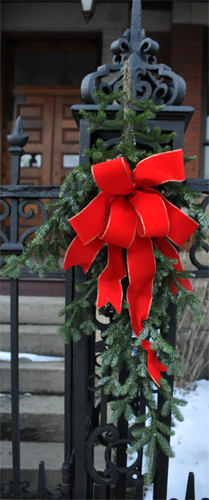
 The newel posts on the wrought-iron fence, at the end of the street, are decorated with boughs of blue pine tied together with red ribbon. On my way home, I decided to head back down and shoot the boughs and ribbons. The sun was at the horizon, but by the time I got down to the house it had set. It was 4:30. (Yes, I know what’s coming – the shortest day of the year, the Winter Solstice . . . the darkness.)
The newel posts on the wrought-iron fence, at the end of the street, are decorated with boughs of blue pine tied together with red ribbon. On my way home, I decided to head back down and shoot the boughs and ribbons. The sun was at the horizon, but by the time I got down to the house it had set. It was 4:30. (Yes, I know what’s coming – the shortest day of the year, the Winter Solstice . . . the darkness.)
Earlier today I was doing some research on the feast-days, listed in the previous post, to see if there was any evidence to support the idea that Andrew the Apostle had created these markers and organized them as precursors to Christmas. Found no information to support this. Instead I found a tradition associated with the feast of Santa Barbara – December 4. In Medieval times, Christians would cut leafless boughs from a cherry tree, bring them indoors and set them in a bucket of water in their kitchens. The belief was that if a bough bloomed then the new year would bring joy. The superstition had ties to the prophecy from the Old Testament from the Book of Isaiah — There shall come forth a Rod from the stem of Jesse, and a Branch shall grow out of his roots. (Santa Barbara was removed from the liturgical calendar of the Roman Rite in 1969. No real evidence that she existed. It’s a good thing them cardinals are selective with this criteria.)
Because the 8th grade stories are about the Advent period of that long ago at St. Veronica’s Elementary, I am using lyrics from the hymn – O Come, O Come Emmanuel – as titles to connect the 8th grade category and the christmas 2013 one. And the image of a pine bough with its scarlet ribbon is a good fit for the title.
December, 1963
Like all good Catholic school children, we got to draw Christmas themed pictures at this time of year. We got to use colored pencils and large paper. The itinerant Art teacher, who came in once a month, made the December lesson great fun. I remember that Mike Bondar drew a picture of the Christ child in a cradle holding a crucifix. (This is the Bondar family of astronaut Roberta Bondar fame.) Sister Drusilla, ever the sarcastic nun, scoffed at Michael’s rendition. He tried to explain that he was foreshadowing what was to come, but Sister would hear none of it. Considering that Michael was not one of the guys I hung with, I shouldn’t have cared that he was being insulted, instead I thought Sister was being overly harsh. He had a good idea and had executed it well. (Lesson learned – stay inside the lines or Sister will yell at you.)
Sister Drusilla was way too literal and closed minded for the likes of thirteen year old Michael or sixty-five year old Maruzzu.


The hymn O come, O come Emmanuel – Veni, Veni Emmanuel – is a synthesis of the great O Antiphons that are used for Vespers during the octave before Christmas (Dec. 17-23). These antiphons are of ancient origin, dating back to at least the ninth century. The hymn itself, though, is much more recent: it first appeared in an 18th century psalmster. There are several arrangements of the hymn. The most common arrangement uses the last of the O Antiphons as the first verse with the next six following in correct order.
It is interesting to note that the initial words of the antiphons in reverse order form an acrostic: O Emmanuel, O Rex, O Oriens, O Clavis, O Radix, O Adonai, O Sapientia. ERO CRAS can be loosely translated as I will be there tomorrow. And tomorrow is Christmas Eve.
| The Hymn | O Antiphons | Dates |
| O come, Thou Wisdom from on high | O Sapientia | December 17 |
| O come, O come Thou Lord of Light | O Adonai | December 18 |
| O come, Thou Rod of Jesse’s stem | O Radix Iesse | December 19 |
| O come, Thou Key of David, come | Clavis Davidica | December 20 |
| O come, Thou Dayspring from on high | O Oriens | December 21 |
| O come, Desire of the nations | O Rex Gentium | December 22 |
| O come, O come Emmanuel | O Emmanuel | December 23 |
I decided to use this post to write about the various Christmas hymns and carols. O Come, O Come Emmanuel was really not a carol that was being widely heard in the 1960’s. (It certainly wasn’t in any muzak collection piped into the stores during the December shopping frenzy.) It was restricted to Sunday Mass. I first heard it, outside of church, at St. Veronica’s during the Advent service led by Sister Drusilla. But it wasn’t until this year that I began to do some research and situated the hymn and the O Antiphons in my Novitiate Breviary in the Advent cycle.
In my mind, I categorize Christmas music: Catholic Christmas music is Latin – Adeste Fideles, In Dulci Jubilo; Italian music is about the child – Gesu Bambino, Tu Scendi dalle Stelle, Mille Cherubini; German and French Christmas music is romantic – Il Est Né, Minuit Chrétiens, O Tannenbaum, Stille Nacht; and American Christmas music is secular – Frosty the Snowman, White Christmas.
Image – Point State Park is all decked out for the holiday. The image is the downtown section of the park looking towards the Northside; the river section is on the other side of the parkway underpass. The entrance to the underpass is on the left of the image.
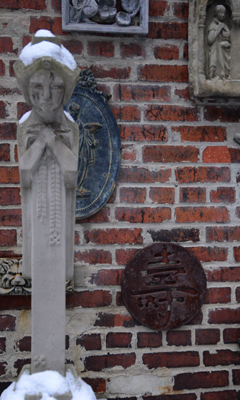
 This posting is going to be a ramble. The monks of The Society of St. John the Evangelist in Cambridge have begun a set of video reflections on the O Antiphons. In two days, I head up to Northern Ontario.
This posting is going to be a ramble. The monks of The Society of St. John the Evangelist in Cambridge have begun a set of video reflections on the O Antiphons. In two days, I head up to Northern Ontario.
December 1963
What I remember most of the winters in Sault Ste Marie, before there was central heating and you heated the house with a coal stove, were the windows decorated with ice-crystals. The sunlight through the frosted glass was bright. At St. Veronica’s the classroom windows did not frost over. And many times I’d look over at the stunted willows that bordered the creek next to the school. (I still can picture the insects that seemed to skate on the water.)
Winter light that far north was always grey. And waiting for Christmas vacation was more about not being in school than presents and family. Tobogganing and street hockey were things to look forward to, but Christmas day had lost some of its luster and I remember thinking that once the noon-day meal was over, a malaise would set in. The local network ran commercials of local businesses wishing us all a Merry Christmas. And daylight was done by 4:00. It was in this down atmosphere that Frank would introduced going to the movies on Christmas Day.
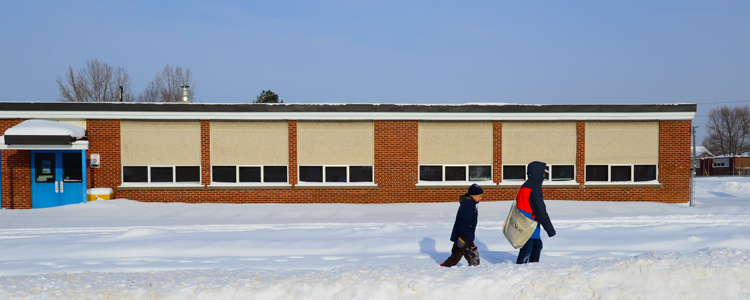

The image is of St. Theresa School. I was here from 2nd to 7th grade. The classroom on the right was my 6th and 7th grade classroom and our teacher was Mr. Orlando. This is the classroom where on a spelling test I spelled the word does DUZ and Mr. Orlando had me go up to the board and write my spelling of the word. I had no idea was I was wrong, but the experience contributed to my insecurities with spelling. (By the time I got to City High, my kids were trained to know that I did not know how to spell and that it was their responsibility to help me.)
This morning we woke up to 3 to 4 inches of new snow and a temperature of 2 degrees. Ciccio insisted on doing his vegetable shopping first thing this morning, so at 8:00 AM we were one of three cars at the No-Frills grocery store.
And for some reason, the public library came to mind as a place for Internet access and sure enough, here I am at the Centennial Branch on Bay Street, with free access. The branch was built in 1966, Canada’s bi-centennial and I remember coming here after school with a bunch of kids to do pretend homework.
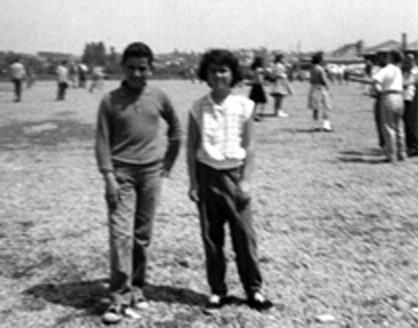

We’d run to the schoolyard and here’s what we did
We’d pick out the captains and we’d choose up the teams
The Paul Stookey lyrics reminded of the summers we spend playing baseball in the field behind Corrine’s house. Baseball was not a game I understood or played well, so right field was the right place for me. Right field extended across the street and into the St. Veronica’s Church parking lot. Still, the ball rarely came in my direction.
The image on the left has little to do with baseball or the field behind Corrine’s, it just seemed to fit. (Janice and I are on the playground at St. Theresa School. I think we were in the 6th or 7th grade.)
I have no idea who provided the ball, the bat, the gloves. For the bases, home-plate and the pitcher’s mound we would trace in the dirt using our shoes to scribe the diamonds and line on the mound.
Ron, Rainer and Frank were good players. Ron and Frank played in the various summer leagues and Rainer and I would ride our bikes to their games. (The bikes were our tickets to exploring the town and we did. Many times Rainer would ride on the handle-bars and the two of us would see how fast we get down a hill.) The league played in fields all over the west end of Sault Ste Marie. My favorites were the ones up on the hills, especially the one on Fourth Line. Fourth Line in those days had little traffic and great dips. We could ride our bikes down the middle of the road and never worry about cars.
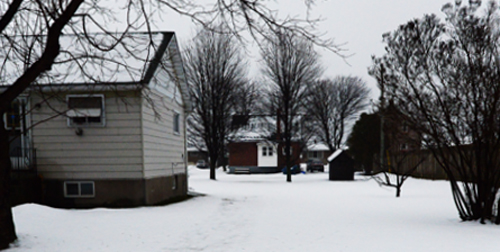
There is a thaw going on, but I need a walk so I head out with my cameras. It really is a pea-soup environment. There isn’t much I can shoot, but with Photoshop I can get rid of some of the gloomy grey. I’m walking down to Ron’s and decide to shoot the empty lot where we used to play baseball. The brick house in the background is where Corrine lived. Sometimes she would play with us. And even though she was a girl she could pitch, hit and run like a boy. The lot was beside Ron’s house and behind Corrine’s. The house on the left of the image was not there.
 Like everything from childhood, the lot looks small. In my mind it was huge. (I’m standing across the street in the church parking lot shooting.) Most of us hit inside the field. Frank Bitonti and Jacky Porco could hit the ball into the church parking lot, so the fielders would back up when they were at bat. (In my old neighborhood, I never played any team sports. The subdivision was just starting to get built and there were not enough kids or established families to organize team sports.)
Like everything from childhood, the lot looks small. In my mind it was huge. (I’m standing across the street in the church parking lot shooting.) Most of us hit inside the field. Frank Bitonti and Jacky Porco could hit the ball into the church parking lot, so the fielders would back up when they were at bat. (In my old neighborhood, I never played any team sports. The subdivision was just starting to get built and there were not enough kids or established families to organize team sports.)
Tonight we head over to my aunt-and-uncle’s. It’ll be a meatless meal with lots and lots of fish options. All the fish will be fried. My aunt, my mother and I will eat spaghetti slathered in anchovies and olive oil; the others will have it with a meatless red-sauce. My uncle is from Aiello – and small mountain town south west of Aprigliano – and in his town the rule was that you left 13 items on the table on Christmas Eve. So after we are all done with dinner, he and my aunt make sure to leave 13 items on the table overnight.
There will be cullurielli – a deep fried sweet dough – made either plain or at Christmas with an anchovy inside. (I like the ones with the anchovies. My friend Chris Colecchia coats the plain ones in powdered sugar and has them for breakfast.) In my extended Calabrese family, the cullurielli are a Christmas tradition and I eat them instead of bread for the time I am here.
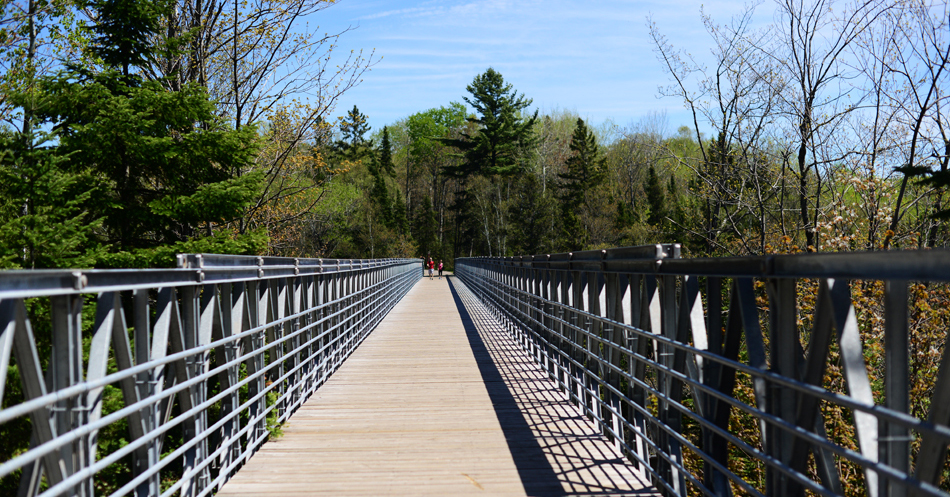

My generation wanted out of the West-End and ran to buy houses in the Protestant East-End. Sir James Dunn High School was the envy of every immigrant living in the West-End. The Dunn was new and full of Canadians. The West End elementary schools were full of immigrant children. (St. Veronica and St. Joseph Elementary were full of children with names like Stocco, Zinga, Bitonti, Pozzobono and Fratesi.)
Forward 50 years and the world has changed. St. Veronica’s and St. Joseph’s are shuttered and the sons and daughters of the immigrants have taken over the political machines. The mayors and aldermen, for the last thirty years, have all had last names ending in vowels. Gone are the McCaigs and the Smiths. And the West-End with its wooded lots and undeveloped ridge has become a magnet for young families and well-to-do families looking for large parcels of land with a view to the Lake.
And the fact that much of the political class has come from the West-End, much of the new development has occurred in the West-End. The above image is of the Fort Creek Conservation Area. The walking path through the area is amazing. The metal bridge in the image is one of three that span the Creek.
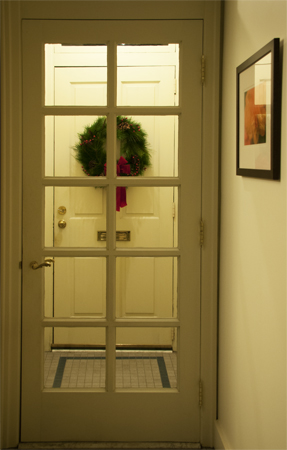
 It’s been a while since I decorated for Christmas and I’m going to use this as an opportunity to weed out ornaments and other chach. I have three huge boxes filled with nut-crackers that haven’t seen the light of days in years. I wonder how they’ve held up.
It’s been a while since I decorated for Christmas and I’m going to use this as an opportunity to weed out ornaments and other chach. I have three huge boxes filled with nut-crackers that haven’t seen the light of days in years. I wonder how they’ve held up.
The image on the left is of the vestibule. I always put the wreath on the inside of the door that way I get to see it. (Putting it on the outside means I only see it when I’m outside. Nah!) I have a second wreath on the kitchen door. It took a while to get the image; I had to take a bunch before I figured out what I wanted and once I decided I wanted the whole door and the whole vestibule, the blue frame in the floor-tile and no transom, then I had to move some things to minimize the number of lines. (I like having the hall-wall and the picture in the upper right, the frame outside the doors matches all the other rectangles in the two doors.)
It’s amazing to research wreaths and to find that they’ve been part of human symbology since the Ancients. Wreaths has been used at funerals since at least the time of Ancient Greece. Evergreen wreaths were laid at the burial place of early Christian virgin martyrs, the evergreen representing the victory of the eternal spirit over death. My first memory of a wreath was in 8th grade at St. Veronica’s. Each Monday in December, Sister Drusilla would march us out to the hall; we would line up on either side of the corridor and we would participate in the Advent ritual of lighting one of the purple candles on the wreath she had placed on a small table. This was followed by the song O Come, O Come Emmanuel.
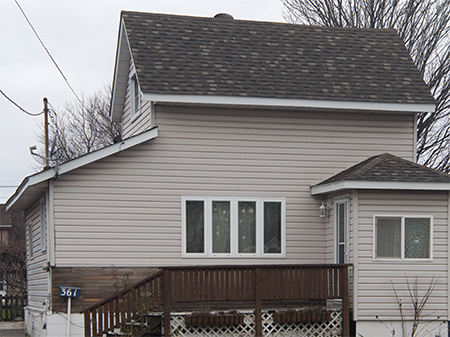
 The image on the right is of the house that the Ingribelli family lived in when I was living here in the far north. The family that I knew is all gone. Frank, who was my age, died of an aneurysm when he was in his early twenties. Dave the youngest died of cancer last year. I vaguely remember the dad; he died before I left. The mom was a big woman, but her life was never the same after Frank passed away. The Ingribelli were related to us through my grandmother and I remember visiting in this house. (The house has since been renovated, but my mom had no problem identifying it. I was walking the neighborhood and when I saw the house, I shot it.)
The image on the right is of the house that the Ingribelli family lived in when I was living here in the far north. The family that I knew is all gone. Frank, who was my age, died of an aneurysm when he was in his early twenties. Dave the youngest died of cancer last year. I vaguely remember the dad; he died before I left. The mom was a big woman, but her life was never the same after Frank passed away. The Ingribelli were related to us through my grandmother and I remember visiting in this house. (The house has since been renovated, but my mom had no problem identifying it. I was walking the neighborhood and when I saw the house, I shot it.)
Prepping for dinner and the incessant Christmas phone calls made the morning a whirlwind. At 7:00 am, my dad got a call from his cousin in Pietrafitta. (Pietrafitta is the next town over from Aprigliano.) This made his day. My paternal grandmother and his cousin’s mother were sisters. The two of them are probably the only remaining Capisciolti from that generation. (Capisciolti was my grandmother’s family name.) From there we moved to my father’s obsession about getting the tables brought in from the garage. Knowing how he can get OCD squared during the prep for Christmas dinner, I let him know last night, that Derrick and I would take care of the tables. Forget that, by 9:00am he was in the garage and had taken down the long table and carried it to the side-door. (This is a 90-year-old, riddled with arthritis, hard-headed Calabrese.) It was only my insistence that he stop with the craziness that got any slow-down. Derrick and I had the table down by 10:30 and it sat there until 2:30 when I set it for dinner.
My mother’s version of Christmas anxiety is to tell me to call all her friends’ children. Her friends and their children are people that I rarely see, but that didn’t seem to deter her. I should call all her friends’ children and wish them Merry Christmas. I didn’t. In addition to this hyper sentimentality, let’s not forget her incessant suggestions of things I need or should eat. (The pushing of food lives side-by-side with us teasing Dave to no end, because he has gained weight.)

 It’s official, we have moved into fall.
It’s official, we have moved into fall.
The rusted lantern sits on top of the fence between my back-yard and Carl’s; the Rose-of-Sharon is in his yard, a legacy of Joe and Rose Ferrara the previous owners.
Try to remember the kind of September when you were a tender and callow fellow